documentary


What is Design Thinking in Education?
In a world where artificial intelligence, exemplified by tools like ChatGPT, is reshaping our world, the human touch of design thinking becomes even more crucial. You might already be familiar with design thinking and curious about how to harness it alongside AI, or perhaps you’re new to this method. Regardless of your experience level, I’m going to share why design thinking is your human advantage in an AI-world. We’ll explore its impact on students and educators, particularly when integrated into the curriculum to design learning experiences that are both innovative and empathetic.
Back in 2017, I spearheaded a two-year research study at Design39 Campus in San Diego, CA, focusing on how educators used design thinking to transcend traditional educational practices. This study was pivotal in understanding how to scale from pockets of innovation to a culture of innovation. It’s rare to see a public school integrate these practices, and I always wondered, “Why is this the exception and not the norm?” How might design thinking when combined with AI tools, complement standards-based curricula by prompting students to tackle real-world challenges. We investigated the methods educators used to learn about design thinking and how they crafted learning experiences at the nexus of knowledge, skills, and mindsets, aiming to foster creative problem-solving in an increasingly AI-integrated world. The results revealed it had nothing to do with the technology. It had to do with people.
Design thinking is both a method and a mindset.
What makes design thinking unique in comparison to other frameworks such as project based learning, is that in addition to skills there is an emphasis on developing mindsets such as empathy, creative confidence, learning from failure and optimism.
Seeing their students and themselves enhance and develop their skills and mindset of a design thinker demonstrated the value in using design thinking and fueled their motivation to continue. In addition, it strengthened their self-efficacy and helped them embrace, not fear change.
The results indicate strong agreement amongst the educators between developing in demand skills such as creativity, problem finding, collaboration and communication and practicing design thinking.

As workplaces determine how to leverage new and emerging technologies in ways that serve humanity, the two critical skills expected will be the ability to solve unstructured problems and to engage in complex communication, two areas that allow workers to augment what machines can do (Levy & Murnane, 2013.)
Brynjolfsson and McAfee (2014) call this era, “The Second Machine Age,” characterized by advances in technology, such as the rise of big data, mobility, artificial intelligence, robotics and the internet of things. The World Economic Forum calls this era, “The Fourth Industrial Revolution.”
Regardless of the name we give this era, Schwab warned, as did Brynjolfsson and McAfee, that failure by organizations to prepare and adapt could cause inequality and fragment societies.
That era that we once talked about, is not here.
The rise of generative Ai.
As Erik Brynjolfsson shares, “There is no economic law that says as technology advances, so does equal opportunity.” The World Economic Forum reinforces this by sharing, that while the dynamics of today’s world have the potential to create enormous prosperity, the challenge to societies, particularly businesses, governments and education systems, will be to create access to opportunities that will allow everyone to share in the prosperity.

Schwab, Brynjolfsson and McAfee advocate for schools being able to play a powerful role in shaping a future that is technology-driven and human-centered. Design thinking, a human-centered framework is one method that can provide educators with the skills and mindset to navigate away from the traditional model established during the industrial area. To a learner-centered vision where we design learning experiences at the intersection of knowledge, skills, and mindsets.
The Future of Work
Designing schools for today’s learner is not just about solving a workforce or technology challenge. It’s also about solving a human challenge, where every individual has the access and opportunity to reach their potential.
Despite the changing expectations of the workplace brought forth by this era, today’s education systems largely remain unchanged. Leaving graduates without the knowledge, skills and mindsets to thrive in future workplaces and as citizens. Furthermore, the lack of equity has led to what Paul Attewell calls a growing digital use divide deepening the fragmentation of society.
A decade ago, some of the most in-demand occupations or specialties today did not exist across many industries and countries. Furthermore, 60% of children in kindergarten will live in a world where the possible opportunities do not yet exist (World Economic Forum, 2017).
In Technology, Jobs and the Future of Work, McKinsey states that 60% of all occupations have at least 30% of activities that can be automated. 40% of employers say lack of skills is the main reason for entry level job vacancies. And 60% of new graduates said they were not prepared for the world of work in a knowledge economy, noting gaps in technical and soft skills. Before our experience with ChatGPT I’m reminded of Imaginable by Jane McGonigal where she shares, “Almost everything important that’s ever happened, was unimaginable shortly before it happened.”
With an influx of technology over the past decade, with iPads and Chromebooks, and now the acceleration of AI technology, particularly over the past year, we have to wonder what gaps exist that prevent us from accelerating and scaling the change we want to see in schools.
One reason is that this challenge is complex and overwhelming. This is where design thinking practices are helpful in moving from idea to impact. Design thinking practices provide the structure and scaffolds needed to take a complex idea and simplify it.
The Design Thinking Process
Too often design thinking is seen as a series of hexagons to jump through. Check off one and move onto the next. Design thinking is a non-linear framework that nurtures your mindset toward navigating change.
It can be used in three areas:
- Problem finding
- Problem solving
- Opportunity exploration
The design thinking model is nonlinear. Resulting in a back and forth between the stages of inspiration, ideation and implementation, in an effort to continuously improve upon their potential solution (Shively et al., 2018). These stages were expanded by the d.School into empathy, define, ideate, prototype and iterate. In fact, there are many exercises that can be used to apply each area of the process.
Let’s walk through each phase. Then I’ll share examples of how it is being used. I also want to preface this by saying that simply going through these stages is where most people misunderstand design thinking and don’t see the results they hoped for. These phases are here to help you develop an action-oriented mindset. Moving from identifying a problem to designing and then testing a solution to quickly get feedback. Each of these phases have numerous exercises to also help facilitate experiences based on your scenario.
Phase 1: Empathy
When you begin with empathy, what you think is challenged by what you learn. This alone is what makes design thinking so unique and is the first phase. During the empathy stage, you observe, engage and immerse yourself in the experience of those you are designing for. Continuously asking, “why” to understand why things are the way they are.
This phase is where we see the most challenges, yet this phase is the most critical. An empathy map is probably the most common exercise. Yet there are others such as, “Heard, Seen, Respected.” Another challenge in this area is not speaking directly to the user. For example, I’ve sat in many “design thinking” experiences where the group will speculate on behalf of the users. For example, educators speculating about parents, administrators speculating about teachers.
The purpose behind an empathy exercise is that when we begin with empathy, what we think is challenged by what we learn. While you can practice with each other, ultimately you must speak directly to who you are designing for.
Phase 2: Define
During the define stage you unpack the empathy findings and create an actionable problem statement often starting with, “how might we…” This statement not only emphasizes an optimistic outlook, it invites the designer to think about how this can be a collaborative approach.
Phase 3: Ideate
During the ideate phase you generate a series of possibilities for design. The focus here is quantity not quality. As you want to generate as many possibilities to see how they may merge together. As Guy Kawasaki shares, “Don’t worry be crappy.” Feasibility is not important at this step. Rather the key is to not think about what is possible but what can be possible. At the end, one of the ideas, or the merging of many ideas, is chosen to expand upon in the next phase.
This is another phase where we see challenges. It is not enough to simply tell someone to get a piece of paper and then come up with lots of ideas. As adults, this is incredibly challenging and is also a muscle that needs to be developed. In fact, one of my favorite exercises is 1-2-4-all. Another is walking questions, where the prompt begins with “What if…” and then after each person writes something it is handed to the person on their right.
Phase 4: Prototype
During the prototype phase, ideas that were narrowed down from ideation are created in a tangible form so that they can be tested. During this phase, the designer has an opportunity to test their prototype and gain feedback.
Phase 5: Iteration
By quickly testing the prototype, the user can refine the idea. And have a deeper understanding to go back and ask questions to the group they are designing for. The feedback received from the user allows the designer to engage in a deeper level of empathy to refine the questions asked and the problem being defined. This brings us back to phase 1.
You can find more of these exercises to lead your group through each phase at sessionlab.com .
As schools strive to create student learning experiences that prepare them for their future, design thinking can play a critical role in complementing students’ knowledge with the skills and mindsets to be creative problem solvers.
Examples of Design Thinking in K12
While new approaches tend to be viewed with skepticism, an increasing number of studies are coming forward reflecting the promise of transferability of skills and mindsets from the classroom to real-world problems when utilizing design thinking. As expectations are raised about what student skills and mindsets are needed, the level of support for educators must increase as well to experience success in new strategies and the outcomes they promise.
When student learning experiences include design thinking, their skills continue to be enhanced and developed. This in turn allows them to apply these strategies to be problem finders and problem solvers. Helping them be more comfortable with change and empowering them to solve unstructured problems. And work with new information, gaining knowledge, skills and mindsets that cannot be found in the confines of a textbook.
In “The Second Machine Age,” the authors share:
Technological progress is going to leave behind some people, perhaps even a lot of people, as it races ahead. As we’ll demonstrate, there’s never been a better time to be a worker with special skills or the right education. Because these people can use technology to create and capture value. However, there’s never been a worse time to be a worker with only “ordinary” skills and abilities to offer, because computers, robots, and other digital technologies are acquiring these skills and abilities at an extraordinary rate. The Second Machine Age | Erik Brynjolfsson | Andrew McAffee
Design thinking strengthens the mindsets and skills that today’s world demands with the ability to become creative problem solvers. Through nurturing the skills and mindsets developed through engaging in design thinking, schools can create more equitable use environments for all learners that leverage technology to accelerate creative tasks that can bridge the digital use divide.
Case Study 1: Design Thinking in Grade 6
A recent study by the Stanford Graduate School of Education highlights that through instruction, students transfer design thinking strategies beyond the classroom. And that the biggest benefits were to low-achieving students (Chin et al., 2019).
The study included 200 students from grade 6. The researchers worked with the educators during class time to coach half the group of students on two specific design thinking strategies. And then assigned them a project where they could apply these skills.
The two strategies included seeking out constructive feedback and identifying multiple possible outcomes to a challenge. Each of these strategies were designed to prevent what the researchers called, “early closure”. Identifying the potential solution before examining the problem.
After class the students were presented with different challenges to see how they would approach them. The students who were taught about constructive criticism asked for feedback when presented with the new challenge and were more likely to go back and revise their work.
This area was significant, as a pre-test revealed that low-achieving students were behind their high achieving peers when seeking out feedback, a gap that the researchers say disappeared after classroom instruction, highlighting the need for this to be taught to all students, not just advanced students in electives.
As Attewell shares, “Placing computers in the hands of every student is not a solution because the challenge lies in addressing the “ digital use divide – changing the tasks that students do when provided with computers.”
He further highlights the students who gain the types of skills highlighted by the Future of Jobs Report are white and affluent students. These students are more likely to use technology to develop trending skills with greater levels of adult support. Whereas minority students are more likely to use it for rote learning tasks, with lower levels of adult support.
While design thinking is often found in pockets, presented to students already interested in this area, or the students who are in certain electives, the study led by the Stanford Graduate School of Education demonstrates the advances that can be made when this is offered to all students.
Case Study 2: Design Thinking in Geography
Another study (Caroll et al., 2010) focused on the implementation of a design curriculum during a middle school geography class. And explored how students expressed their understanding of design thinking in classroom activities, how affective elements impacted design thinking in the classroom environment and how design thinking is connected to academic standards and content in the classroom. The students were a diverse group with 60% Latino, 30% African-American, 9% Pacific Islander and 1% White.
The task was for students to use the design process to learn about systems in geography. The study found that students increased their levels of creative confidence. And that design thinking fostered the ability to imagine without boundaries and constraints. A key element to success was that educators needed to see the value of design thinking. And it must be integrated into academic content.
A challenge often associated with design thinking in education is not integrating it into mainstream education as an equitable experience for all learners despite showing that lower achieving students benefit more (Chin et al, 2019).
If students are to experience dynamic learning experiences, then organizations must raise the level of support for educators and give them the time and space to learn and integrate design thinking.
How Educators Use Design Thinking
Educators are facing a number of challenges in their professional practice. Many of the requirements today are tools and methods they did not grow up with. Furthermore, the profession is tasked with designing new methods often within traditional systems that have constraints that may serve as roadblocks to change (Robinson & Aronica, 2016).
A 2018 study by PwC with the Business Higher Education Forum shared that an average of 10% of K-12 teachers feel confident incorporating higher-level technology that affords students the opportunity to use technology to design learning that is active, not passive.
As a result, students do not spend much time in school actively practicing the higher-level trending skills expected by employers. Moreover, the report shows that more than 60% of classroom technology use is passive, while only 32% is active use. While the study suggests that many teachers do not have the skills to engage students in the active use of technology, 79% said they would like to have more professional development for how to leverage technology to design learning that is active.
Case Study 3: Design39 Campus
As I shared earlier I led a two-year research study at Design39 Campus. The study examines how it helped teachers evolve their practice. At Design39 teachers are called “Learning Experience Designers” (LEDs). Borko and Putnam (1995) share that how educators think is related to their knowledge. To understand how LEDs are using design thinking to complement the standards-based curriculum, it was important to understand how they acquired and applied this knowledge.
Despite design thinking having its roots outside of education, when asked, “What does design thinking mean to you?” The LEDs identified many commonalities amongst their own work as educators and design thinking. Moreover, they appreciated the alignment of their work with the vocabulary and structure of the design thinking framework.
Over 50% of the LEDs interviewed identified design thinking as providing them with a common vocabulary and structure for what they already do. The LEDs identified educators as inherent design thinkers due to the shared human-centered focus of working with users. In this experience educators design challenges with cyclical learning tasks involving testing, feedback and iteration, and a design mindset to address the wide variety of complex problems within their individual classrooms and across education organizations.
One LED shared:
I just look at it as a process, a process in my mind that we kind of naturally go through as educators, and so with the design thinking process I feel that it is codifying what we do and so we start off always in empathy and empathy is the heart of design thinking and so we are problem solving, who are we problem solving for – people, our learners and so this entire process that we go through of brain dumping it, trying it, getting feedback and coming back to it again so that we can make sure we were really insightful about what the problem really was for the users and we continue around this process to fine tune a potential solution is the design thinking process. Learning Experience Designer | Design39 Campus
One of the ways mastery of knowledge is demonstrated is by teaching others. To assess their mastery of design thinking in education, learning experience designers were asked to describe their confidence in teaching someone else how to integrate design thinking into their curriculum.

Many LEDs acknowledged that although this is what it often looked like in the first year of the school opening, they have since had the time, space and collaborative opportunities to explore and create deeper integration. This was a point of reference mentioned by 78% of LEDs.
I think a lot of people see design thinking as one science activity, we design think everything from rules to problems that come up in the playground, it’s all through the day, they (the learners) are always looking for problems to solve. Learning Experience Designer | Design39 Campus
In another example, four LEDs made a note using the exact same language that “design thinking is not always cardboard and duct tape.” What allows them to design learning that is more meaningful one LED highlighted:
Not every day is about using duct tape and cardboard, sometimes to do the design to solve the problems you have to hunker down and read and research and so some days, design thinking is highlighting and taking notes. Learning Experience Designer | Design39 Campus
Another LED elaborated on this idea by sharing that
Design thinking is a way of thinking, not always a product that is created at the end. Learning Experience Designer | Design39 Campus
LEDs in all focus groups shared how ultimately design thinking was an opportunity to design lessons that are “ bigger than we are .”
This allowed for the LEDs to design learning experiences. With this, the end result was not to just design a potential solution to a challenge that was identified. Or to simply go from one standard to another, checking off boxes along the way, but that the solution, the work the learners were doing lived beyond the classroom for an authentic audience, where learners are working on real world problems and presenting their solutions to a real world audience.
Almost all of the LEDs shared that to them design thinking was a mindset. It is a process of inquiry that allowed for a more human centered environment where the learner was the focus.
This highlighted a critical shift in the culture at Design39, an element Sarason (2004) discussed in saying no one ever asks:
“Why is school not a place where educators learn as well?”
Bring a Design Thinking Workshop to Your School
We’ve invested in technology. Now it’s time to invest in people. Let’s discuss how design thinking practices can enhance the work you are doing in your school, giving everyone the mindset and skills to navigate change with enthusiasm and optimism. Use this calendar to schedule a time with Sabba to discuss bringing a workshop to your school. Workshops can be delivered both virtually and in-person.

Attewell, P. (2001). The first and second digital divides. Sociology of Education, 74(3), 252-259
Borko, H., & Putnam, R.T. (1995). Expanding a teacher’s knowledge base: A cognitive psychological perspective on professional development. In T. Gusky & M. Huberman (Eds), Professional development in education: New paradigms and practices (pp.35-65). Teachers College Press.
Brown, T & Wyatt, J. (2010). Design thinking for social innovation. Stanford Social Science Review, 8 (1), 30-35.
Brynjolfsson, E. (2014). The second machine age: Work, progress, and prosperity in a time of brilliant technologies (1st t ed.). W. W. Norton & Company.
Carroll, M., Goldman, S., Britos, L., Koh, J., Royalty, A., & Hornstein, M. (2010). Destination, imagination and the fires within: Design thinking in a middle school classroom. International Journal of Art and Design Education, (29)1, 37-53.
Chin, D. B., Doris, Blair, K.P., Wolf, R., & Conlin, L., Cutumisu, M., Pfaffman, J., Schwartz, D.L. (2019). Educating and measuring choice: A test of the transfer of design thinking in problem solving and learning. Journal of the Learning Sciences. 1-44.
Levy, F., & Murnane, R. (2013). Dancing with Robots. NEXT Report.
McKinsey Global Institute (2017). Technology, Jobs and the Future of Work. McKinsey.
PwC (2017). Technology in U.S. Schools: Are we preparing our students for the jobs of tomorrow . Pricewater House Coopers. https://www.pwc.com/us/en/about-us/corporate-responsibility/library/preparing-students-for-technology-jobs.html .
Robinson, K., & Aronica, L. (2016). Creative schools: the grassroots revolution that’s transforming education. Penguin Books.
Shively, K., Stith, K.M., & Rubenstein, L.D. (2018). Measuring what matters: Assessing creativity, critical thinking, and the design process. Gifted Child Today, 41(3) 149-158.
World Economic Forum. (2018). The future of jobs: Employment, Skills and Workforce Strategy for the Fourth Industrial Revolution . World Economic Forum.

I believe that the future should be designed. Not left to chance. Over the past decade, using design thinking practices I've helped schools and businesses create a culture of innovation where everyone is empowered to move from idea to impact, to address complex challenges and discover opportunities.
stay connected

designing schools
[…] importance of learning experiences at the intersection of developing learning skills and mindsets. Design thinking is one approach that can help you master both. In my experience it’s rare that design thinking […]
Leave a Reply Cancel reply
Your email address will not be published. Required fields are marked *
Save my name, email, and website in this browser for the next time I comment.
This site uses Akismet to reduce spam. Learn how your comment data is processed .
« How Education Leaders Use Social Media to Build Trust, Encourage Creativity, and Inspire a Collective Vision
Creative Career Map: How Students Can Navigate the Future of Work with Design Thinking »

Browse By Category
Social Influence
Design Thinking

Join the Community
All of my best and life changing relationships began online. Whether it's a simple tweet, a DM or an email. It always begins and ends with the relationships we create. Each week I'll send the skills and strategies you need to build your human advantage in an AI world straight to your inbox.
As Simon Sinek Says: "Alone is hard. Together is better."
©DesigningSchools. All rights reserved. 2023
Instagram is my creative outlet. It's where you can see stories that take you behind the scenes and where I love having audio chats in my DM.
@designing_schools
Browse Course Material
Course info, instructors.
- Prof. Justin Reich
- Elizabeth Huttner-Loan
- Alyssa Napier
Departments
- Supplemental Resources
As Taught In
- Education Policy
- Educational Technology
Design Thinking for Leading and Learning
Course description.
How do we prepare K-12 students and learning communities to be as successful as possible? If future jobs require creativity, problem-solving, and communication, how do we teach these skills in meaningful ways? How do we bring together passionate school leaders to create systemic solutions to educational challenges? …
How do we prepare K-12 students and learning communities to be as successful as possible? If future jobs require creativity, problem-solving, and communication, how do we teach these skills in meaningful ways? How do we bring together passionate school leaders to create systemic solutions to educational challenges? Come explore these questions and more in Design Thinking for Leading and Learning.
The course is organized into three sections that combine design thinking content with real-world education examples, as well as opportunities for learners to apply concepts in their own setting.
This course is part of the Open Learning Library , which is free to use. You have the option to sign up and enroll in the course if you want to track your progress, or you can view and use all the materials without enrolling.

You are leaving MIT OpenCourseWare
Design in Educational Technology: Design Thinking, Design Process, and the Design Studio
- Graphic Design
Research output : Book/Report › Book
This book is the result of a research symposium sponsored by the Association for Educational Communications and Technology [AECT]. The fifteen chapters were developed by leaders in the field and represent the most updated and cutting edge methodology in the areas of instructional design and instructional technology. The broad concepts of design, design thinking, the design process, and the design studio, are identified and they form the framework of the book. This book advocates the conscious adoption of a mindset of design thinking, such as that evident in a range of divergent professions including business, government, and medicine. At its core is a focus on "planning, inventing, making, and doing." (Cross, 1982), all of which are of value to the field of educational technology. Additionally, the book endeavors to develop a deep understanding of the design process in the reader. It is a critical skill, often drawing from other traditional design fields. An examination of the design process as practiced, of new models for design, and of ways to connect theory to the development of educational products are all fully explored with the goal of providing guidance for emerging instructional designers and deepening the practice of more advanced practitioners. Finally, as a large number of leading schools of instructional design have adopted the studio form of education for their professional programs, we include this emerging topic in the book as a practical and focused guide for readers at all levels.
Bibliographical note
Publisher link.
- 10.1007/978-3-319-00927-8
Other files and links
- Link to publication in Scopus
- Link to the citations in Scopus
Fingerprint
- Design Process Keyphrases 100%
- Design Thinking Keyphrases 100%
- Design Studio Keyphrases 100%
- Educational Technology Design Keyphrases 100%
- Educational Technology Arts and Humanities 100%
- Instructional Designs Arts and Humanities 100%
- Instructional Design Social Sciences 66%
- Designer Arts and Humanities 50%
T1 - Design in Educational Technology
T2 - Design Thinking, Design Process, and the Design Studio
AU - Hokanson, Brad
AU - Gibbons, Andrew
N1 - Publisher Copyright: © Springer International Publishing Switzerland 2014. All rights are reserved.
PY - 2014/1/1
Y1 - 2014/1/1
N2 - This book is the result of a research symposium sponsored by the Association for Educational Communications and Technology [AECT]. The fifteen chapters were developed by leaders in the field and represent the most updated and cutting edge methodology in the areas of instructional design and instructional technology. The broad concepts of design, design thinking, the design process, and the design studio, are identified and they form the framework of the book. This book advocates the conscious adoption of a mindset of design thinking, such as that evident in a range of divergent professions including business, government, and medicine. At its core is a focus on "planning, inventing, making, and doing." (Cross, 1982), all of which are of value to the field of educational technology. Additionally, the book endeavors to develop a deep understanding of the design process in the reader. It is a critical skill, often drawing from other traditional design fields. An examination of the design process as practiced, of new models for design, and of ways to connect theory to the development of educational products are all fully explored with the goal of providing guidance for emerging instructional designers and deepening the practice of more advanced practitioners. Finally, as a large number of leading schools of instructional design have adopted the studio form of education for their professional programs, we include this emerging topic in the book as a practical and focused guide for readers at all levels.
AB - This book is the result of a research symposium sponsored by the Association for Educational Communications and Technology [AECT]. The fifteen chapters were developed by leaders in the field and represent the most updated and cutting edge methodology in the areas of instructional design and instructional technology. The broad concepts of design, design thinking, the design process, and the design studio, are identified and they form the framework of the book. This book advocates the conscious adoption of a mindset of design thinking, such as that evident in a range of divergent professions including business, government, and medicine. At its core is a focus on "planning, inventing, making, and doing." (Cross, 1982), all of which are of value to the field of educational technology. Additionally, the book endeavors to develop a deep understanding of the design process in the reader. It is a critical skill, often drawing from other traditional design fields. An examination of the design process as practiced, of new models for design, and of ways to connect theory to the development of educational products are all fully explored with the goal of providing guidance for emerging instructional designers and deepening the practice of more advanced practitioners. Finally, as a large number of leading schools of instructional design have adopted the studio form of education for their professional programs, we include this emerging topic in the book as a practical and focused guide for readers at all levels.
UR - http://www.scopus.com/inward/record.url?scp=85029564974&partnerID=8YFLogxK
UR - http://www.scopus.com/inward/citedby.url?scp=85029564974&partnerID=8YFLogxK
U2 - 10.1007/978-3-319-00927-8
DO - 10.1007/978-3-319-00927-8
AN - SCOPUS:85029564974
SN - 9783319009261
BT - Design in Educational Technology
PB - Springer International Publishing
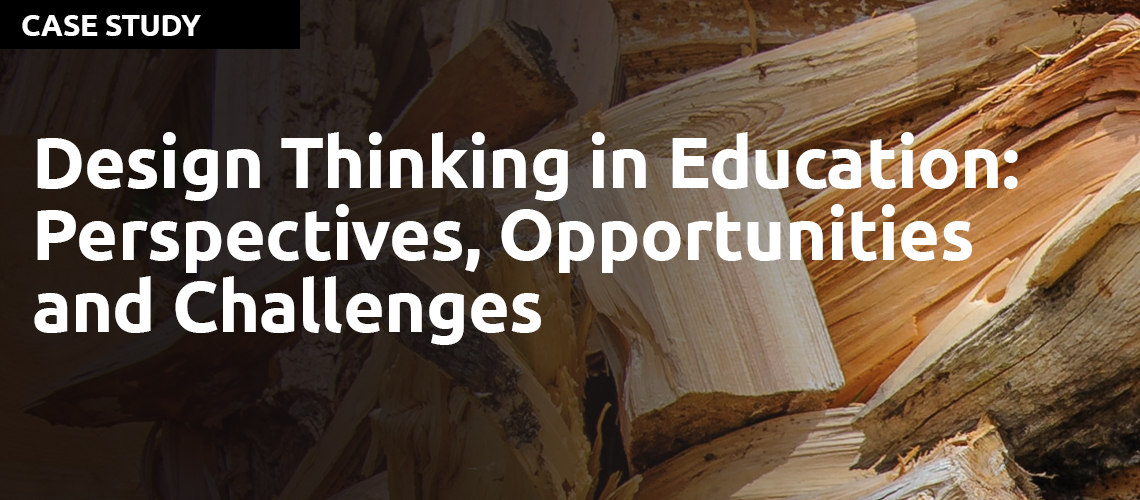
Design Thinking in Education: Perspectives, Opportunities and Challenges
This very informative article discusses design thinking as a process and mindset for collaboratively finding solutions for wicked problems in a variety of educational settings. Through a systematic literature review the article organizes case studies, reports, theoretical reflections, and other scholarly work to enhance our understanding of the purposes, contexts, benefits, limitations, affordances, constraints, effects and outcomes of design thinking in education.
Specifically, the review pursues four questions:
- What are the characteristics of design thinking that make it particularly fruitful for education?
- How is design thinking applied in different educational settings?
- What tools, techniques and methods are characteristic for design thinking?
- What are the limitations or negative effects of design thinking?
The goal of the article is to describe the current knowledge base to gain an improved understanding of the role of design thinking in education.
Read more...
- Our Mission
Design Thinking
Find and share resources to help students engage in innovative processes for tackling complex real-world problems in human-centered ways.
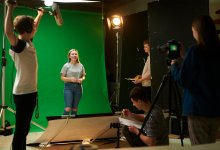
.css-13ygqr6:hover{background-color:#d1ecfa;}.css-13ygqr6:visited{color:#979797;}.css-13ygqr6.node--video:before{content:'';display:inline-block;height:20px;width:20px;margin:0 4px 0 0;background:url(data:image/svg+xml,%3Csvg%20width%3D%2242px%22%20height%3D%2242px%22%20viewBox%3D%220%200%2042%2042%22%20alt%3D%22Video%20icon%22%20data-testid%3D%22play-circle%22%20version%3D%221.1%22%20xmlns%3D%22http%3A%2F%2Fwww.w3.org%2F2000%2Fsvg%22%3E%3Ctitle%3EVideo%3C%2Ftitle%3E%3Cdefs%3E%3C%2Fdefs%3E%3Cg%20id%3D%22play-circle%22%20fill%3D%22%23000000%22%3E%3Cpath%20d%3D%22M21%2C0%20C9.38%2C0%200%2C9.38%200%2C21%20C0%2C32.62%209.38%2C42%2021%2C42%20C32.62%2C42%2042%2C32.62%2042%2C21%20C42%2C9.38%2032.62%2C0%2021%2C0%20L21%2C0%20Z%20M21%2C36.7733333%20C12.32%2C36.7733333%205.22666667%2C29.7266667%205.22666667%2C21%20C5.22666667%2C12.2733333%2012.32%2C5.22666667%2021%2C5.22666667%20C29.68%2C5.22666667%2036.7733333%2C12.32%2036.7733333%2C21%20C36.7733333%2C29.68%2029.68%2C36.7733333%2021%2C36.7733333%20L21%2C36.7733333%20Z%22%20id%3D%22circle%22%3E%3C%2Fpath%3E%3Cpath%20d%3D%22M29.54%2C19.88%20L17.7333333%2C12.9733333%20C16.8466667%2C12.46%2015.7733333%2C13.1133333%2015.7733333%2C14.0933333%20L15.7733333%2C27.9066667%20C15.7733333%2C28.9333333%2016.8933333%2C29.54%2017.7333333%2C29.0266667%20L29.5866667%2C22.12%20C30.4266667%2C21.6066667%2030.4266667%2C20.3933333%2029.54%2C19.88%20L29.54%2C19.88%20Z%22%20id%3D%22triangle%22%3E%3C%2Fpath%3E%3C%2Fg%3E%3C%2Fsvg%3E) no-repeat left bottom/18px 18px;} Filmmaking Is a Powerful Way for Students to Demonstrate Learning

Flexible Seating and Student-Centered Classroom Redesign
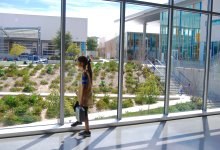
Designing a Public School From Scratch

Crafting Fair Assessments for Flexible Assignments
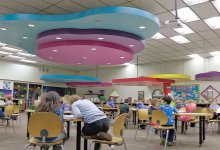
Birmingham Covington: Building a Student-Centered School

Design Thinking: A Problem Solving Framework
Teaching empathy through design thinking.
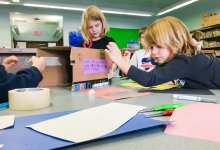
Designed for Engagement

Science Takes Flight With Paper Airplanes

Arts Integration: Resource Roundup

Using Design Thinking to Explore Inclusivity

Why Learning Space Matters

Incorporating Design Thinking in the Study of Literature
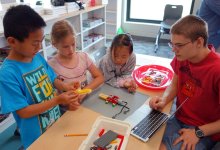
Design Thinking in Education: Empathy, Challenge, Discovery, and Sharing
As a model for reframing methods and outcomes, design thinking reconnects educators to their creativity and aspirations for helping students develop as deep thinkers and doers.

Building Products for Real-World Clients
We will keep fighting for all libraries - stand with us!
Internet Archive Audio

- This Just In
- Grateful Dead
- Old Time Radio
- 78 RPMs and Cylinder Recordings
- Audio Books & Poetry
- Computers, Technology and Science
- Music, Arts & Culture
- News & Public Affairs
- Spirituality & Religion
- Radio News Archive

- Flickr Commons
- Occupy Wall Street Flickr
- NASA Images
- Solar System Collection
- Ames Research Center

- All Software
- Old School Emulation
- MS-DOS Games
- Historical Software
- Classic PC Games
- Software Library
- Kodi Archive and Support File
- Vintage Software
- CD-ROM Software
- CD-ROM Software Library
- Software Sites
- Tucows Software Library
- Shareware CD-ROMs
- Software Capsules Compilation
- CD-ROM Images
- ZX Spectrum
- DOOM Level CD

- Smithsonian Libraries
- FEDLINK (US)
- Lincoln Collection
- American Libraries
- Canadian Libraries
- Universal Library
- Project Gutenberg
- Children's Library
- Biodiversity Heritage Library
- Books by Language
- Additional Collections

- Prelinger Archives
- Democracy Now!
- Occupy Wall Street
- TV NSA Clip Library
- Animation & Cartoons
- Arts & Music
- Computers & Technology
- Cultural & Academic Films
- Ephemeral Films
- Sports Videos
- Videogame Videos
- Youth Media
Search the history of over 866 billion web pages on the Internet.
Mobile Apps
- Wayback Machine (iOS)
- Wayback Machine (Android)
Browser Extensions
Archive-it subscription.
- Explore the Collections
- Build Collections
Save Page Now
Capture a web page as it appears now for use as a trusted citation in the future.
Please enter a valid web address
- Donate Donate icon An illustration of a heart shape
Design in educational technology : design thinking, design process, and the design studio
Bookreader item preview, share or embed this item, flag this item for.
- Graphic Violence
- Explicit Sexual Content
- Hate Speech
- Misinformation/Disinformation
- Marketing/Phishing/Advertising
- Misleading/Inaccurate/Missing Metadata
![[WorldCat (this item)] [WorldCat (this item)]](https://archive.org/images/worldcat-small.png)
plus-circle Add Review comment Reviews
37 Previews
Better World Books
DOWNLOAD OPTIONS
No suitable files to display here.
PDF access not available for this item.
IN COLLECTIONS
Uploaded by station12.cebu on November 11, 2022
SIMILAR ITEMS (based on metadata)

What is Design Thinking? A Handy Guide for Teachers
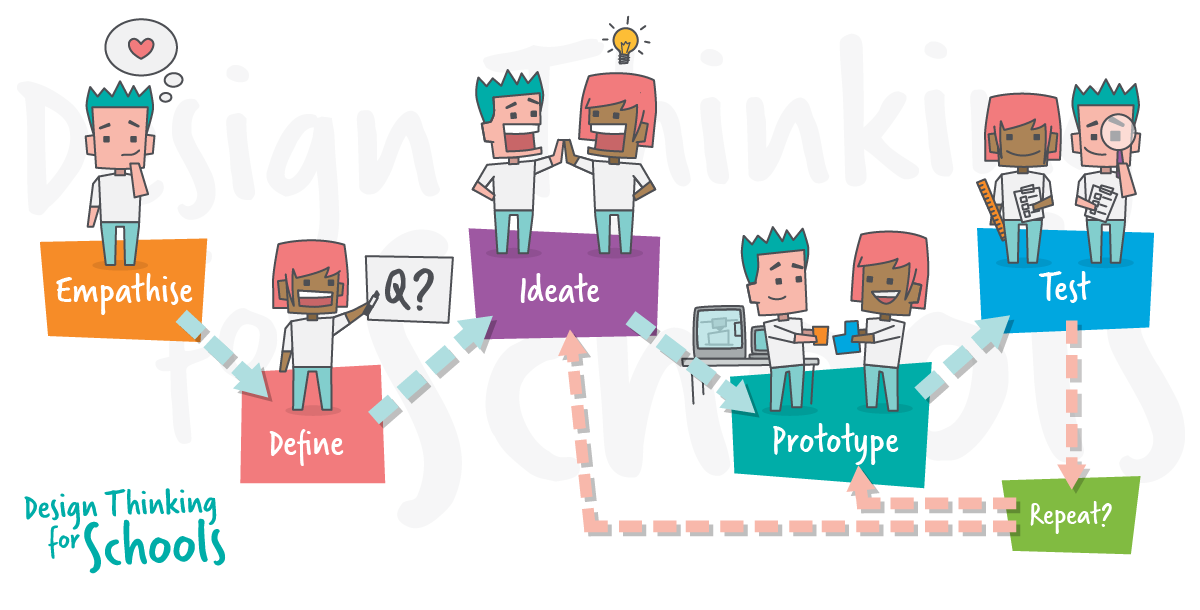
In this post, Mandi Dimitriadis, Director of Learning at Makers Empire, will help you understand more about Design Thinking. You’ll get to know what Design Thinking is, why Design Thinking is important, the phases of the Design Thinking process and how you might teach your students how to use Design Thinking to reframe problems and needs as actionable statements.
Designers use particular ways of thinking to create innovative new products and design solutions to challenging problems. As educators, we can learn a lot from the way designers think.
What is Design Thinking?
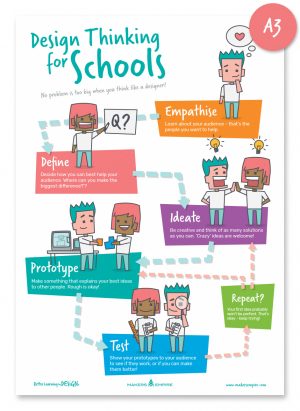
- A solutions-based approach to solving problems.
- An iterative, non-linear process.
- A way of thinking and working.
- Supported by a collection of strategies and methods.
- Develop empathy and understand the needs of the people we are designing solutions for.
- Define problems and opportunities for designing solutions.
- Generate and visualise creative ideas.
- Develop prototypes.
- Test solutions and seek feedback.

Why is Design Thinking important?
Consider the rapidly changing world we live in. To thrive in the future students will need to be adaptable and flexible. They will need to be prepared to face situations that they have never seen before. Design Thinking is one of the best tools we can give our students to ensure they:
- Have creative confidence in their abilities to adapt and respond to new challenges.
- Are able to identify and develop innovative, creative solutions to problems they and others encounter.
- Develop as optimistic, empathetic and active members of society who can contribute to solving the complex challenges the world faces.
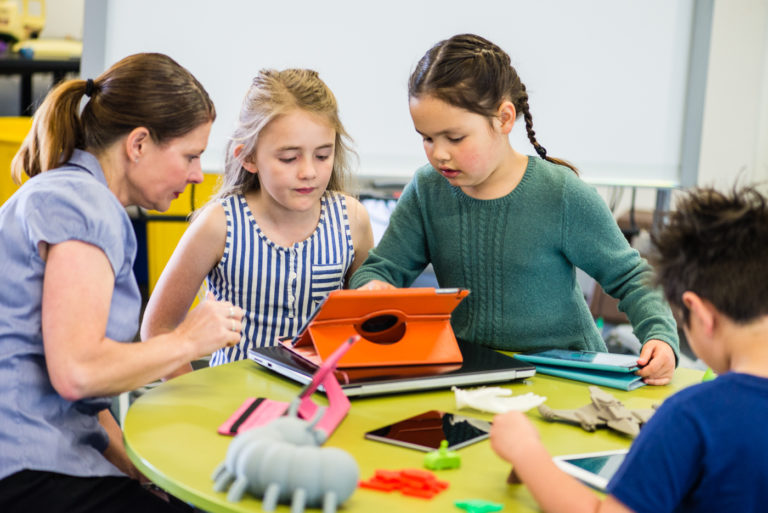
How can students use Design Thinking?
So what does Design Thinking look like in action?
Watch these inspiring videos made by schools in Australia showing how students used Design Thinking and Makers Empire to solve common real-world problems in their classroom, school and communities.
Please note that the Makers Empire app depicted in this video is a much earlier version of the app.
How did the students in the videos use design thinking.
In the Forbes primary school bag tag video, for example, we saw our first graders:
- Developing and agreeing on criteria for their designs.
- Selecting tools and materials – in this case, Makers Empire and 3D printing.
- Supporting each other to learn how to use the new tools.
- Producing a working prototype.
The testing process for our first graders involved:
- Giving each other feedback
- Assessing their designs against the previous agreed criteria
- Making modifications and improvements to their designs
- Testing their designs in the context they would be used.
- Reflecting on their problem-solving processes and learning outcomes.
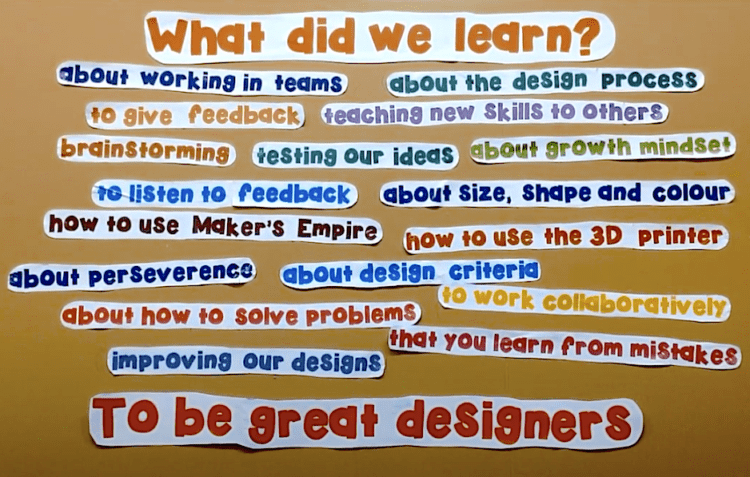
How can we teach Design Thinking with little time to plan?
Makers Empire teachers never cease to impress us with their innovative and creative ideas for using Makers Empire to help students achieve curriculum learning outcomes. However, we also know how busy teachers are and how difficult it can be to find time to plan engaging, curriculum-aligned units of work. So we created ready-made Challenge Courses .
Each themed course is a complete design program comprising videos, quizzes, tutorials & design challenges. Challenge Courses are aligned to curriculum outcomes and teach real world-problem solving using Design Thinking. Challenge courses take 4-10 weeks to complete so teachers might plan to have students do a course during one lesson/week over a term. During that term, students will address all aspects of the Design and Technologies curriculum without teachers needing to do any extra planning.
How can we learn more about Design Thinking?
Makers Empire offers customisable Design Thinking and 3D design learning programs to school districts, education departments , and groups of schools .
Through our professional learning programs, teachers learn how to use Design Thinking and 3D design to transform the way they teach STEM subjects and help equip students with the skills and attitudes they’ll need to thrive in the future.
We’ve delivered Design Thinking and 3D technology programs to groups of 200+ schools in Australia, America and the Middle East so we have the right experience, skills and team to help you.
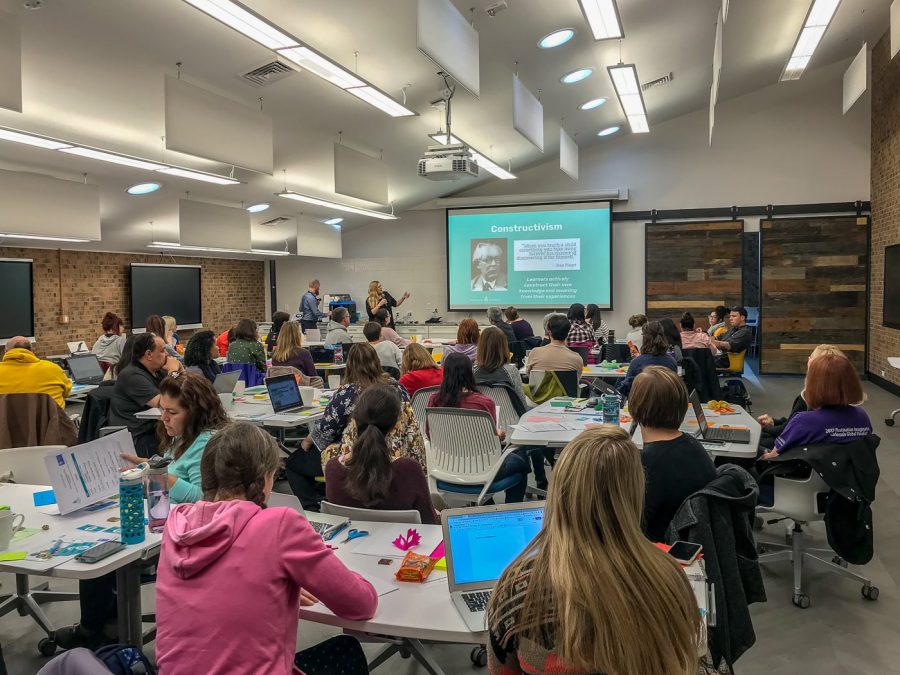
How will you teach Design Thinking?
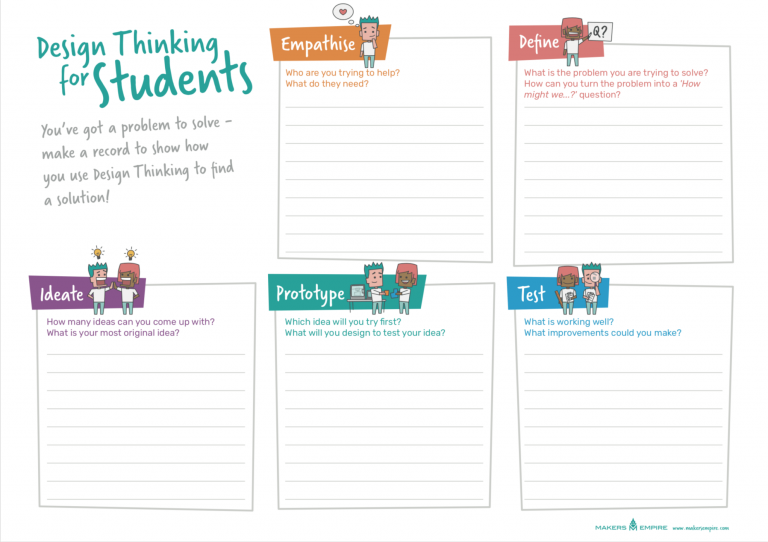
Now it’s your turn. Think about projects you can do with your students that will help enhance and deepen learning. How might you support your students to:
- Develop empathy , insights and understandings.
- Define a problem as an actionable question.
- Generate and visualise ideas.
- Develop prototypes; and
- Evaluate and test their designed solutions.
Makers Empire is an excellent way to teach Design Thinking to students. You can sign up for a free school trial at the top of this website. Don’t forget to download our free Design Thinking posters and worksheets , too.

Mandi Dimitriadis
Mandi Dimitriadis, DipT. is a highly respected educator and speaker who works internationally with elementary, primary and middle schools to help teachers develop Design Thinking, embrace maker pedagogy and cover Design & Technology Curriculum. She is an experienced classroom teacher who recognises the power of technology to enhance teaching and improve educational outcomes. Mandi has extensive experience with curriculum development, having previously developed programs for the Australian Government’s Department of Education.
How to Enhance Design Thinking with ChatGPT
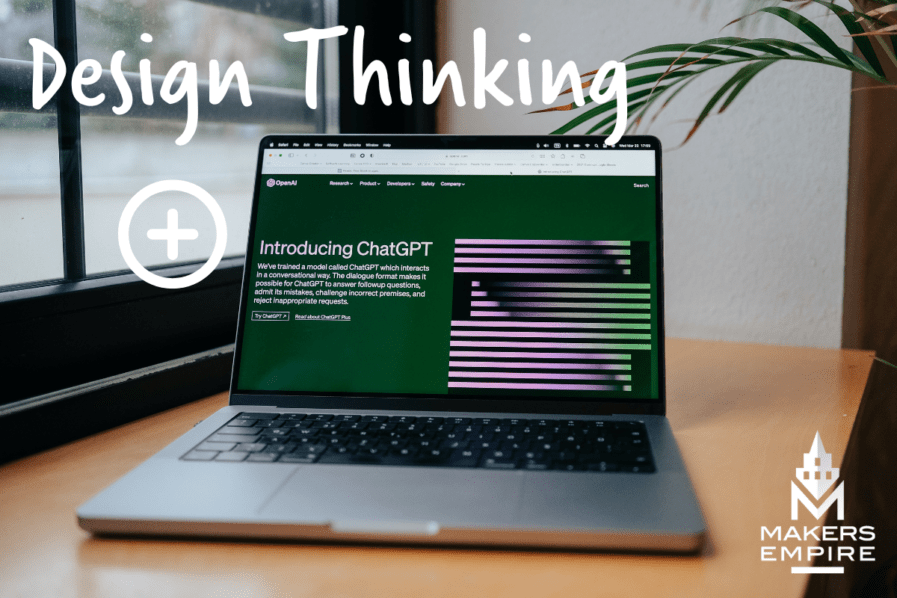
New technologies are always posing challenges in the educational sector. It’s not the technology that’s the issue, but the people and processes. Educators’ approaches to these digital advancements must not be to deny their existence but to understand how they can be used to transform assessment. AI tools, such as ChatGPT, offer students access to a wealth of information and can be most useful as research and practice guides in active and applied problem-solving tasks such as those used in design thinking.
So how can teachers embrace ChatGPT and use it to enhance design thinking approaches?
ChatGPT is capable of facilitating the generation of novel ideas, enhancing creativity and improving product development (Haleem, 2022). It can reinforce the principles of design thinking through its ability to generate student centred solutions with its iterative problem solving approach (Enhold, 2022). For each of the phases in design thinking, ChatGPT can be a useful tool.
Share this:

2024 Makers Empire Projects for Australian Schools
Makers Empire has hit the ground running again in 2024 with our pop…
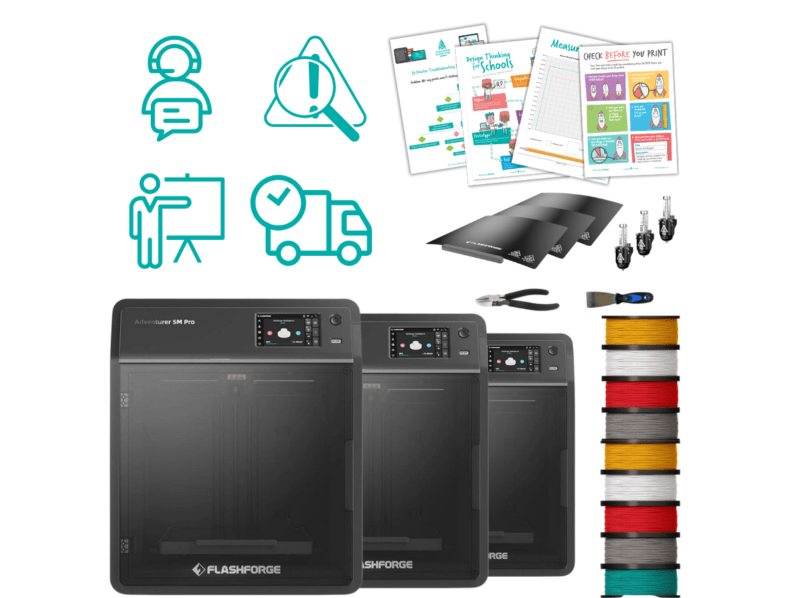
Review of the 2024 Flashforge Adventurer 5M Pro 3D Printer: A True Leap Forward
Flashforge has released a new Pro version of their popular Adventur…
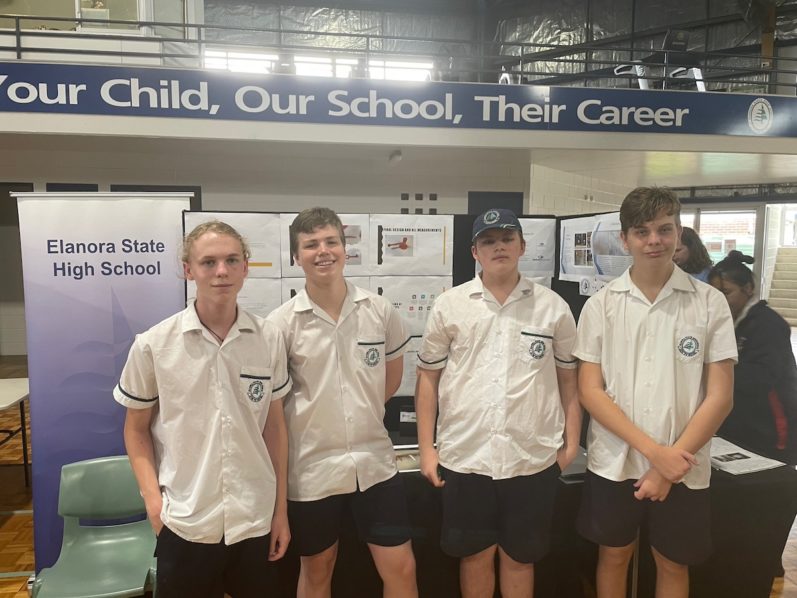
Register Your Interest for the 2024 STEM Advanced Manufacturing Moreton Bay Future Skills School Program
Following successful programs in Queensland in 2023, junior and sen…

Learning at Home | Coronavirus | COVID-19 | Resources for Teachers and Parents
To the worldwide Makers Empire community, At Makers Empire, we̵…
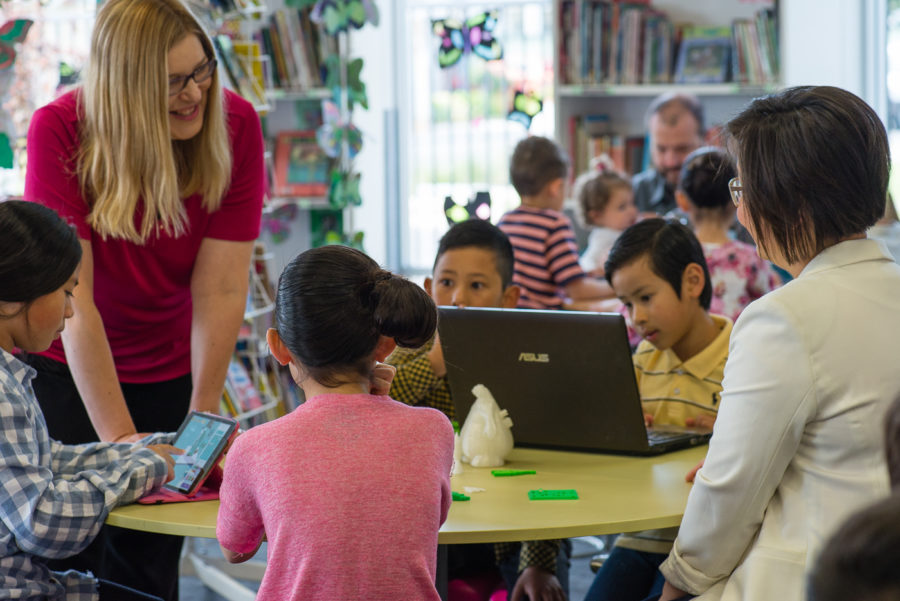
Failing to Succeed: 6 Habits of Successful ‘Failers’ That Teachers Should Know
I spend a lot of time talking with teachers about the important rol…
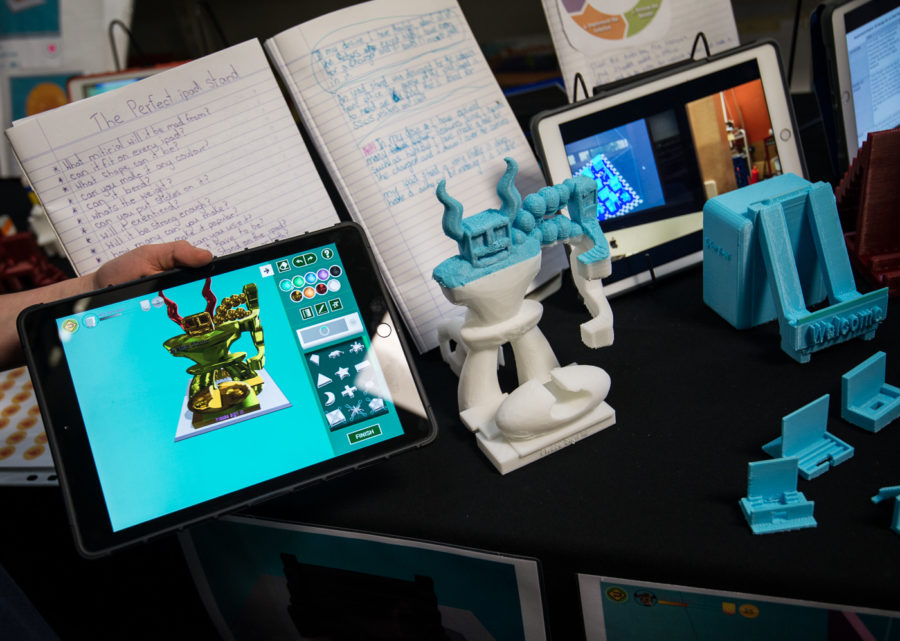
Competitions, Challenges & Experiences Your Students Will Love | Design Thinking | STEM
At Makers Empire, we want to help children become creators, innovat…
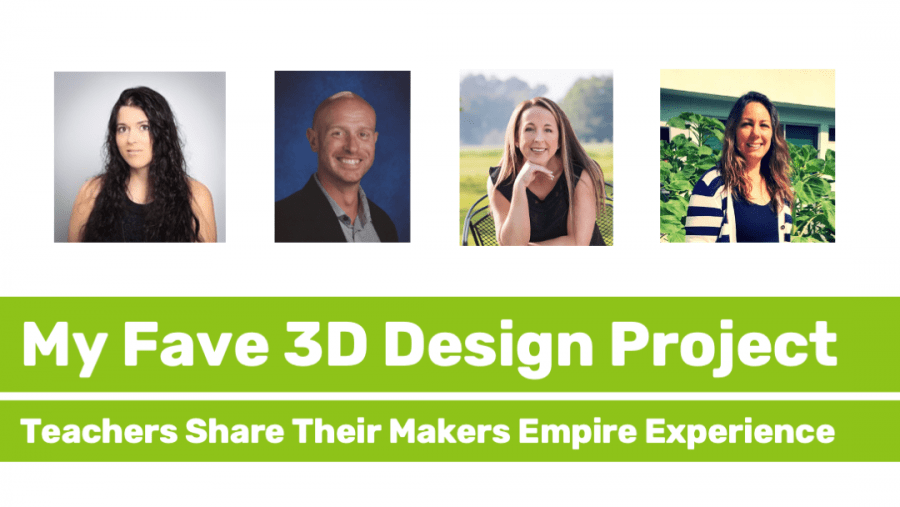
[Videos] American Teachers Share Their Fave Makers Empire Projects, Aha! Moments & Tips
We recently asked some of our American elementary and middle school…

10 Coronavirus 3D Design Challenges For Students | Help People Affected By COVID-19
We’ve seen a recent surge of activity around the world as health au…

10 Design Challenges for Children To Help Create Positive Feelings During COVID-19
We are all navigating unchartered territory as we learn to cope wit…
Try Makers Empire for free!
Start learning 3D design in minutes. Make teaching design and technology fun and effective!
- USA (415) 652 0206
- AUS 61 (0)8 8120 3150
- Contact Makers Empire
- Get Tech Support
- Knowledgebase / FAQs
- 3D Design Software
- Class & School Subscriptions
- Learning by Design Course
- Custom Solutions
- Shop Makers Empire
- Knowledgebase
- Technical Support
- Free Printables
- Education Research
- Grants for Schools
- Makers Empire Blog
- Gallery of Designs
- Our Teachers
- Teacher Interviews
- Monthly Competitions
- Our Partners & Awards
- In the News
- Testimonials
- Major Milestones
- Terms of Service | Privacy
We acknowledge and pay our respects to the Kaurna people, the traditional custodians whose ancestral lands we gather on. We acknowledge the deep feelings of attachment and relationship of the Kaurna people to country and we respect and value their past, present and ongoing connection to the land and cultural beliefs.
Please wait while you are redirected to the right page...

Design Thinking for Education
Conceptions and Applications in Teaching and Learning
- © 2015
- Joyce Hwee Ling Koh 0 ,
- Ching Sing Chai 1 ,
- Benjamin Wong 2 ,
- Huang-Yao Hong 3
National Institute of Education, Singapore, Singapore
You can also search for this author in PubMed Google Scholar
National Chengchi University, Taipei, Taiwan
Examines Design Thinking from an education context
Provides better understanding of applications of design thinking in educational settings
Stimulates conversation among educational researches to further consider the theoretical development of Design Thinking
40k Accesses
75 Citations
13 Altmetric
This is a preview of subscription content, log in via an institution to check access.
Access this book
- Available as EPUB and PDF
- Read on any device
- Instant download
- Own it forever
- Compact, lightweight edition
- Dispatched in 3 to 5 business days
- Free shipping worldwide - see info
- Durable hardcover edition
Tax calculation will be finalised at checkout
Other ways to access
Licence this eBook for your library
Institutional subscriptions
Table of contents (8 chapters)
Front matter, design thinking and education.
- Joyce Hwee Ling Koh, Ching Sing Chai, Benjamin Wong, Huang-Yao Hong
Critical Perspectives on Design and Design Thinking
Design thinking and 21st century skills, design thinking and children, design thinking and preservice teachers, design thinking and in-service teachers, developing and evaluating design thinking, back matter.
- 21st century skill
- design thinking and children
- design thinking and students
- design thinking and teachers
- design thinking in education
- design thinking in teaching and learning
- lesson planning
- reflection in action
- learning and instruction
About this book
“The authors clearly define the aims of the text as being to further the debate amongst teachers, teacher educators and educational researchers on the theoretical development of design thinking within the context of educational settings. … a book that would hold appeal for all of those with an interest in design thinking in an educational context, irrespective of their position; educational researcher. pre-service teacher, in-service teacher or teacher educator. … I recommend this text as essential reading … .” (David Wooff, Design and Technology Education, Vol. 21 (3), 2016)
Authors and Affiliations
Joyce Hwee Ling Koh, Ching Sing Chai, Benjamin Wong
Huang-Yao Hong
Bibliographic Information
Book Title : Design Thinking for Education
Book Subtitle : Conceptions and Applications in Teaching and Learning
Authors : Joyce Hwee Ling Koh, Ching Sing Chai, Benjamin Wong, Huang-Yao Hong
DOI : https://doi.org/10.1007/978-981-287-444-3
Publisher : Springer Singapore
eBook Packages : Humanities, Social Sciences and Law , Education (R0)
Copyright Information : Springer Science+Business Media Singapore 2015
Hardcover ISBN : 978-981-287-443-6 Published: 11 May 2015
Softcover ISBN : 978-981-10-1333-1 Published: 23 October 2016
eBook ISBN : 978-981-287-444-3 Published: 25 April 2015
Edition Number : 1
Number of Pages : XII, 131
Number of Illustrations : 1 b/w illustrations, 5 illustrations in colour
Topics : Teaching and Teacher Education , Learning & Instruction
- Publish with us
Policies and ethics
- Find a journal
- Track your research
YOUR RESOURCE FOR EMPOWERING LEARNERS

Educational Technology
(edtech) resource, stem education & educational technology (edtech).
.jpg)
Click here for other podcast platforms.
David Lee
Tech & Innovation Specialist at Singapore American School
Author of Design Thinking in the Classroom , Google Innovator,
Apple Distinguished Educator, ISTE Certified Educator, Keynote Speaker, Consultant, Certified Wix Trainer, M.Ed. Educational Technology,
Former STEM Coordinator, Design Specialist, and ICT Teacher

Official partner of DesignGoes2School
"Design education is revolutionizing minds and transforming perspectives even beyond privileged communities to the slums. Moulding the dreamers' dream into life and birthing a design-savvy generation with zero limits."

Thanks for submitting!
Exploring the Training Path of Design Thinking of Students in Educational Technology
Ieee account.
- Change Username/Password
- Update Address
Purchase Details
- Payment Options
- Order History
- View Purchased Documents
Profile Information
- Communications Preferences
- Profession and Education
- Technical Interests
- US & Canada: +1 800 678 4333
- Worldwide: +1 732 981 0060
- Contact & Support
- About IEEE Xplore
- Accessibility
- Terms of Use
- Nondiscrimination Policy
- Privacy & Opting Out of Cookies
A not-for-profit organization, IEEE is the world's largest technical professional organization dedicated to advancing technology for the benefit of humanity. © Copyright 2024 IEEE - All rights reserved. Use of this web site signifies your agreement to the terms and conditions.
- Research article
- Open access
- Published: 26 April 2024
(No) Hope for the future? A design agenda for rewidening and rewilding higher education with utopian imagination
- Rikke Toft Nørgård ORCID: orcid.org/0000-0003-0481-6683 1 &
- Kim Holflod 1
International Journal of Educational Technology in Higher Education volume 21 , Article number: 30 ( 2024 ) Cite this article
347 Accesses
6 Altmetric
Metrics details
This article argues for exploring, connecting, and applying utopian imagination, speculative design, and planetary thinking as a way forward for higher education to reimagine and move towards more hopeful planetary futures. It examines hopepunk and solarpunk perspectives on possible futures to propose a design agenda for rewidening and rewilding higher education and educational technology with utopian imagination. Firstly, the article outlines and develops a framework for wider and wilder futures in higher education, emerging from utopian thinking and desire. Secondly, it connects hopepunk with speculative design and solarpunk with planetary design to highlight and put forward rebellious strategies of hope in envisioning more preferable futures. Thirdly, it approaches the field of educational technology within the context of wide and wild education to establish four planetary orientations concerning educational technology: Higher Education for, in, with, and by the world. Taken together, the article proposes a design agenda for educational technology that integrates utopian imagination and solarpunk practices with planetary educational technology to catalyse the development of more preferable futures in a more-than-human world.
Grimdark and narrow futures in higher education
What does a world that works for everyone look like? How can it translate to higher education institutions? And what role or potential lies within utopian imagination to think, talk, and act critically, holistically, and reflexively in both anticipating and shaping higher education futures?
This article argues for exploring, connecting, and applying utopian imagination, speculative design, and planetary thinking as a way forward for higher education – that also resonates with and has implications for the domain of educational technology – to reimagine and desire more just and hopeful futures. The term utopia generally refers to an imagined, ideal, and often perfect society, while the term dystopia is utopias dark twin pointing towards the undesirable society marked by negative qualities or frightening characteristics. This article applies the concepts to examine and discuss potential futures. In this context, hopepunk and solarpunk attitudes – are specific value-driven rebellious utopian strategies originating from popular and aesthetic culture and often point towards collective and imaginative bettering of worlds through radical hope and planetary justice and consciousness. Here, such approaches are coupled with orientations of higher education as being for , in , with , and by the world, that might help guide us towards futures that transcend present dull and domesticated educational utopias (Webb, 2016 ). It is, however, important to acknowledge that any discussions centered on more hopeful or just futures inherently involve making normative judgments, where some futures are deemed more preferable than others.
The normative dimensions of designing for possible futures relate to, for instance, Voros’ concept of preferable futures within futures studies (Voros, 2001 ), Nelson & Stolterman’s foregrounding of desiderata , the pursuit of that-which-ought-to-be and materialising the ideal in the real within design studies (Nelson & Stolterman, 2014 ), along with Levitas’ utopia as method and utopian imagination (Levitas, 2013 ) and other applications of utopian thinking within higher education studies (see, e.g., Amsler & Facer, 2017 ; Barnett et al., 2022 ; Bayne, 2023 ; Nørgård, 2022 ; Ross, 2022 ), that all underscore this normative dimension. Such notions of higher education oriented towards educating for utopian desire (Abensour, 1999 ) not solely grounded in ‘pragmatic feasibility’ or ‘realistic futures’ necessitates a transformation of both higher education institutions themselves and our own perspectives and relationships with the world around us.
Neglecting our interconnected existence with each other, the planet, and the entangled web of more-than-human entities and futures leaves us trapped in bleak and challenging present circumstances inside and outside our higher education institutions. As such, there are calls to envision alternative futures – both in and beyond higher education – that extend thinking toward a deeper notion of relationality (e.g., Akama et al., 2020 ; Escobar, 2017 ) and necessary radical change in social systems because of an ecological imperative and planetary challenges (Levitas, 2017 ), and, consequently, new approaches towards considering the futures of educational technology (Macgilchrist, 2021 ). To progress forward, we require, on the one hand, more utopian imaginative models and hope-driven attitudes to envision futures that are genuinely worth pursuing. On the other hand, we also need a less ego-centric and more eco-centric mindset of planetary sensibilities to believe that these envisioned futures are planet-wide and hopeful for ‘all of us’.
The climate crisis and the looming specter of a planetary catastrophe have given rise to the emergence of various educational approaches, including eco-pedagogies (Kahn, 2010 ; Molina-Motos, 2019 ; Misiaszek, 2020 ), post-anthropocentric and post-human thinking (Banerji & Paranjape, 2016 ; Bodén et al., 2021 ; Braidotti, 2013 ; Bridle, 2022 ; Snaza et al., 2014 ) and a planetary turn in design (Akama et al., 2020 ; Samson & Haldrup, 2023 ; Wahl, 2016 ). These responses are potential strategies to address the increasing tangibility of societal and planetary dystopian scenarios and grimdark futures, both in everyday life and educational settings. Moreover, discussions within and surrounding higher education about the Anthropocene and Capitalocene bring attention to an era shaped by human activities and a concept linked to environmental degradation influenced by the dynamics of capitalism and its related economic and social structures. These discussions, especially concerning the neoliberal and performative aspects of universities and higher education, underscore how domesticated, dull, and pessimistic prospects have come to exert influence on higher education institutions. This influence has constrained and altered the perspectives and actions of academic individuals, including students and teachers alike (Ball, 2003 ).
While there is a consensus among higher education scholars regarding the necessity for change, the scope and vision of this change vary widely. Some advocate for more pragmatic and incremental shifts, while others adopt a more holistic and imaginative stance (Levitas, 2004 , 2013 ; Webb, 2016 ). The latter group emphasises the need to envision alternative futures and propose methods and modes of thinking that can actively contribute to the discovery and process towards more hopepunk futures that connect to a contemporary movement and aesthetic about speculating, changing, and bettering the world and its future(s) through its emphasis on optimism, cooperation, community-building, the rejection of apathy, and the embodiment of radical hope.
In the context of higher education and educational technologies, there is a need for improved frameworks and methodologies to evaluate our current practices, considering the state and prospects of desired and preferable futures for us all, both human and more-than-human entities, in a planetary and pluriversal perspective. This foundational approach to shaping the future closely aligns with design practices found in speculative design (Dunne & Raby, 2013 ), design fiction prototyping (Bleecker at al., 2022 ), and approaches to designing for improved educational futures (Abegglen et al., 2023 ; Hall et al., 2022 ). These transformative design approaches depart from our existing anticipatory regimes in education (Amsler & Facer, 2017 ), where we consistently find ourselves shaping the future of higher education and educational technologies based on projected and predictable dull futures that are essentially already present in our current reality. To envision wider and wilder futures, drawing conceptual inspiration from Arturo Escobar ( 2017 ), accentuating the pluriversal design imperative of wider , i.e., people-wide, and wilder , i.e., planet-wide, it is important to design beyond pragmatic real utopias , as criticised by Webb ( 2016 ), and for futures that are more than practically achievable and realistically feasible, given the current situation and the foreseeable future on the horizon.
Here, the article examines and proposes an alternative perspective to counteract the practice of domesticating and narrowing future scenarios. Consequently, the approach diverges from more conventional notions of fostering human optimism or striving for planetary justice when discussing educational technologies in higher education. Here, we advocate for a more-than-human approach (Akama et al., 2020 ), emphasising the entangled relationality of humans and non-humans and recognising the complex agency of the non-human in the, e.g., biological, social, and cultural worlds, which challenges the prevailing discourse in educational technology theory and practice. Such more-than-human approaches, combined with planetary and solarpunk attitudes, prioritise people-wide (hopepunk) and planet-wide (solarpunk) utopian imaginations for preferable futures. They do so at the expense of capitalism’s perpetual growth and totalitarian technologies’ dominance, as Levitas ( 2017 ) argues. This offers a path forward for educational design and technology, which often grapple with the looming specter of exclusively human-centered or ‘Global North’ anticipatory futures in higher education. The array of potential futures confronting us in higher education is vast and dynamic. Importantly, these futures are not binary utopian or dystopian outcomes that can be definitively reached. Instead, they represent an ongoing (r)evolutionary process, where certain actions may lead us toward grimdark educational landscapes while others may guide us toward more radical and hopeful ones (Nørgård, 2022 ). In other words, this article explores the full array of futures – from the present grimdark to the imaginative hopepunk and solarpunk, and from the dull, domesticated, and predictable futures to wider and wilder preposterous futures (see Fig. 1 ).
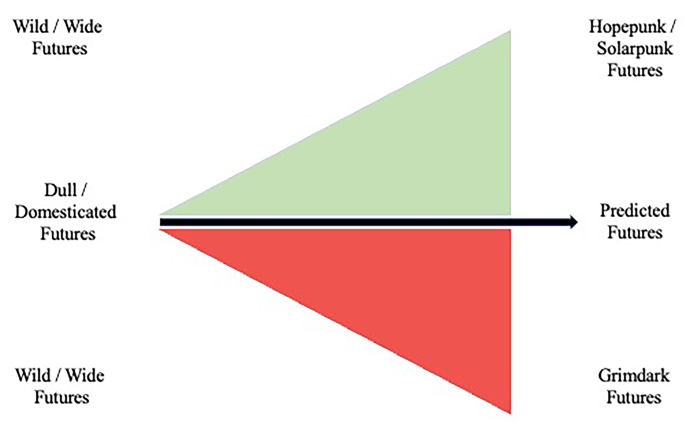
The domain of all possible futures we are confronted with in higher education. The ones close to the predicted future (in the singular) are dull and domesticated, while the ones spanning the outer cone are wilder and wider. The first half of the cone leads us into more grimdark futures; the other half leads us into more hopepunk futures
Through cultivating hopepunk and solarpunk attitudes within the field of higher education and educational technology, as well as rewidening and rewilding higher education using utopian imagination, the article points towards more hopeful, preferable futures for the people and the planet.
First, the article outlines and develops an imaginative model for wider and wilder futures in higher education, growing from utopian thinking and desire. This section emphasises the interplay between utopian imagination and design approaches such as speculative design and future scenarios. Second, extending utopian examination and reflection, we connect speculative design with the popular cultural phenomenon of hopepunk that accentuates rebellious strategies of hope in envisioning better, more hopeful futures. From here, as the third part of the article, we extend the mentioned perspectives through planetary design and solarpunk concepts, moving beyond the human-centric perspective towards eco-centric future-making for the planet. Finally, the article approaches the field of educational technology within the context of wide and wild higher education, establishing four planetary orientations through educational technology: Higher education for the world, Higher Education in the world, Higher Education with the world, and Higher Education by the world.
Imagining with hope toward utopian higher education futures
In the introduction, we outlined alternative approaches to thinking about higher education futures and educational technologies, namely hopepunk, solarpunk, wider and wilder futures, utopian and dystopian futures, and both human and more-than-human approaches – and a need to emphasise more just, desirable, and preferable planet- and people-wide futures for ‘all of us’ that encompass the agencies of not only humans but also more-than-humans. Perhaps we should, then, dare to dream of wider and wilder futures - and herein not approach utopia as a feasible destination but as an ever-moving, ever-evolving future world to continuously strive for. For this, we must escape present-day utopian studies and approaches in higher education that have become domesticated (Webb, 2016 ). As such, there is a pressing need to advance and imagine wilder and wider higher education utopias that do not merely ‘predict’ the future or point towards ‘probable’ futures but, rather, make us engage the multiple ‘possible’ futures – even ones that might initially be deemed ‘preposterous’ (see Voros, 2017 for a description of the different kinds of possible futures).
Utopia is etymologically conceptualised as a no place or nowhere , often connected to and framed by acts of social dreaming. However, utopian studies – particularly in higher education - are vast, diverse, contested, and plural, accentuating, e.g., both real utopias, possible/feasible utopias, and imaginative utopias. Here, we draw inspiration from Levitas ( 1990 , 2013 , 2017 ) to advance and explore the concept of utopia in higher education. We approach this idea from various perspectives, such as holistic, critical, imaginary, reflexive, prescriptive, normative, contingent, and future-oriented angles (Levitas, 2004 , 2013 : 84). Our goal is not just to envision what might be but to imagine otherwise . Levitas, moreover, frames the interdependencies among economic, social, existential, and ecological processes within an integrated framework. Challenges arise when our attention is predominantly directed towards analysing and explaining existing phenomena, referred to as that which-is , thereby neglecting the realm of ethical and moral considerations denoted as that-which-ought-to-be . Additionally, this oversight transpires without regard for the preferences and longings resonating from that-which-is-desired (desiderata), as Nelson and Stolterman ( 2012 ) explained. As such, “the point is not for utopia to assign ‘true’ or ‘just’ goals to desire but rather to educate desire, to stimulate it, to awaken it…. Desire must be taught to desire better, to desire more, and above all to desire otherwise.” (Abensour, 1999 : 146). Levitas draws attention to the perspective that pragmatic and feasible utopias are not enough and that we will only end up with more of the same if we do not demand the impossible (or preposterous) (Levitas, 2004 ). We might thus say that higher education systems need holistic, hopeful utopias – utopias of social dreaming (Dunne & Raby, 2013 ), collective visioning (Wahl, 2016 ), extended relationality (Holflod, 2023b ), and hopepunk imagination (Nørgård, 2022 ). However, education of desire and imaginative utopias are not consistently eutopias , i.e., always positive, but more critical and reflexive towards desiderata . Addressing utopian studies in line with this perspective, Fitting ( 2009 , p. 12) accentuates the following:
It is a mistake to approach Utopias with positive expectations, as though they offered visions of happy worlds, spaces of fulfillment and cooperation, representations which correspond generically to the idyll or the pastoral rather than the utopia. Indeed, the attempt to establish positive criteria of the desirable society characterizes liberal political theory from Locke to Rawls, rather than the diagnostic interventions of the Utopians, which, like those of the great revolutionaries, always aim at the alleviation and elimination of the sources of exploitation and suffering, rather than at the composition of blueprints for bourgeois comfort. (Fitting, 2009 , p. 12)
Levitas’ utopian approach might allow us to imagine what an alternative society could look like and even what it might feel like to inhabit it (Levitas, 2017 , p. 3) when “utopia is the expression of the desire for a better way of being or of living, and as such is braided through human culture” (Levitas, 2013 , p. xii). Moreover, she emphasises that we must perceive and engage with utopia primarily as a method rather than a destination. This method involves provisional, reflexive, and dialogic processes (Holflod et al., 2023 ) and enactments of collective visioning and processual future-making (Barnett et al., 2022 ). As educational design researchers, this understanding corresponds with speculative design as a way of stimulating idealism (Holflod, 2023a ; Nørgård, 2022 ), reminding us of alternative and imaginable worlds and not something to make real – but as somewhere to aim for rather than build. (Dunne & Raby, 2013 , 73). Acknowledging the domestication of educational utopias (Webb, 2016 ), we thus might need to envision imaginative and preposterous but possible futures – for utopian visions towards a plurality of both voices, ways of knowing, and societal re-constitution (Levitas, 2013 ).
With imaginative and hopepunk utopian higher education futures possibly sounding abstract and preposterous, speculative design and design futures might be tangible ways of grounding such a utopian approach. In our discussions – with educators, students, and practitioners - about possible and imaginable futures, we have found inspiration in the futures cone that frames and directs our utopian thinking in classifications of utopia (see Fig. 2 ) as projected, probable, plausible, possible, and preposterous in relation to an imagined future (Voros, 2017 ). These different classes represent different ways of thinking towards the future – best thought of as nested classes of futures moving from the narrowest projected future (in the singular) to the broadest seemingly preposterous futures. Notably, the cone of possible futures is ever-expanding (except for the projected singular future) as we move further and further into the future, indicating trajectories rather than destinations. As a tangible tool for envisioning alternative futures, the futures cone might help guide and widen our imagination. Though it might not be tailored specifically to the utopian approach expressed by Levitas, it provides a tangible framework for exploring, analysing, and pursuing different classes of possible futures – even wildly imaginable, reflexive, and critical – higher education futures.
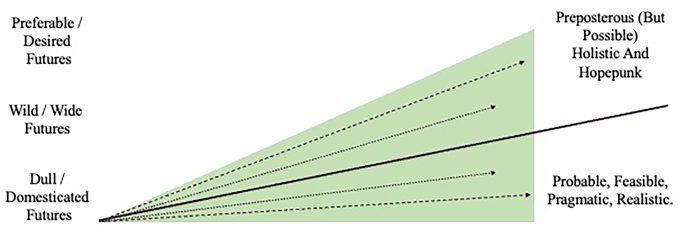
The domain of all preferable and desired futures we might imagine within higher education. The pathways close to the dull and domesticated futures (bottom of triangle) are probable and ‘realistic’, while the pathways unfolding in the upper half of wilder/wider futures are ‘preposterous’ and holistic. The bottom half leads us into domesticated utopias as preferable and probable futures to settle for, while the other half leads us into utopian imagination towards desired and hopepunk futures for people and planets
Speculative design and hopepunk higher education: re-widening futures
In the previous section, we argued that transcending pragmatic utopian perspectives towards, e.g., holistic, hopepunk and processual future imagination is needed. As such, a shift from a predictive/projected to a visionary/hopepunk attitude towards higher education institutions – and herein educational technologies – is critical:
There are several ways of looking at the future, but two methods predominate. The first is by prediction and the second is ‘visioning’. Prediction is, perforce, based on extrapolation of past trends. Through this process the future can only be viewed as though along a corridor of constraining possibilities. The corridor might widen along its length but the process of prediction is essentially a restrictive one. Visioning, on the other hand, is a process that begins with the desired future state and then looks backwards to the present (building a new corridor between the states). Visioning is a tool that, under various guises, has been developed by the business community to help corporate planning. The present state can be a difficult barrier to what could be – the future state (Stewart, 1993). Therefore, visioning is radically different from conventional futurology which is predictive, prophetic and tends to offer pictures of exaggerated optimism or pessimism. (McRae, 1994) (in Wahl, 2006 , p. 714).
Within a speculative design approach, this needs to happen from the bottom up (Dunne & Raby, 2013 ) to escape totalitarian utopian ‘blueprint’ frameworks or fixed destinations and have in their place ever-evolving micro-utopias of collective visions. Building on the utopian method enables us to imagine more hopeful futures and evoke both personal and collective desire as ‘that things might be otherwise, and might be better, is the defining characteristic of utopian thought’ (Levitas, 2017 , p. 6). However, to rewiden our futures under the present realities of higher education, we need a certain kind of hope. To not ‘just be hopeful’ (Dunne & Raby, 2013 ), we must invoke hopepunk attitudes as more rebellious stances towards both the present and future.
Hopepunk is more than conjuring an idealistic, bright vision of the future. By engaging in discussions about futures worth having and problems in working towards them, the community of higher education thinkers and technologists can engage in processes of collective visioning about (more) preferable futures and approach design processes to materialise them (Wahl, 2006 , 2016 ). Here, hopepunk thinkers and practitioners can come together to engage utopian imagination through design agendas to materialise pathways towards more just and hopeful futures. According to Aja Romano, hopepunk is not a naïve optimist or purely hopeful state – but an active political choice ‘made with full self-awareness that things might be bleak or even frankly hopeless, but you’re going to keep hoping, loving, being kind nonetheless’ (Romano, 2018 ). It is, on the one hand, a utopian insistence on believing in the possibility of wilder and wider futures and then fighting for those preferable futures to happen, and, on the other hand, rebellion against dull and domesticated futures that diminish our utopian imagination and belief in that things could be otherwise.
Hopepunk signals an anti-nostalgic, forward-looking stance against the grimdark and encroaching darkness of the present world. It is characterised by a utopian imagination of softness and wholesomeness that advocates taking concrete action towards building positive and preferable worlds: ‘Hopepunk is a radical call to arms for us to imagine better […] To embrace the fact that fantasy is not simply an escape from the world but an invitation to go deeper into it. That we must fall in love with the world that we so deeply wish to change (Romano, 2018 ). Accordingly, hopepunk embraces a futures-oriented activist punk attitude or approach to the world grounded firmly in virtues such as care, compassion, community, love, and friendship. Here, utopian imagination, speculative design, and preposterous but possible futures run in the veins of hopepunk as a mode of resisting the encroaching closing of the projected future. However, relevant current criticism of and reflection on hopepunk as a movement of ‘weaponised positivity’ lies in its lack of inclusion of diverse races, that are illuminated by a disconnect between those canonised and those self-identifying as hopepunk artists and creators, along with a rapid rise and fall of the genre in popular culture (Mancuso, 2021 , pp. 21–22). But, as we explain in the below sections, we find insightful and activist potentials in hopepunk as an attitude or approach to contribute to the design agenda and strategies of working towards more hopeful, just, and planetary futures.
Mancuso criticises hopepunk and creates the concept of “multiplicative speculation”, denoting the multiplication of possible futures that might be imagined by displaying numerous different possibilities and reminding us that things could be different (Mancuso, 2021 , p. 4), which – though different – resonates with the same set of ideas and design strategies proposed in this article of imagining alternative and better worlds for all. The design equivalent of hopepunk is speculative design, which evokes desire from hope and extends towards preferable futures. Within speculative design, futures are opened in hopepunk ways to define preferable futures worth having and worthwhile fighting for collectively. These are futures emerging from ‘speculating more’ within higher education and concerning educational technologies. It is not ‘positive design’, but future practices fuelled by speculating through design, by testing out different potential futures and scenarios while translating our utopian imagination into tangible designs. Constantly questioning what is given, speculative design aims to open wider futures by creating alternatives to examine, test, and enact in a dialogic space between preferable futures and present reality. It is imagination at work in the crevices between reality as we know it (and the projected/probable future we think will come into being) and the ever-widening array of all possible futures (as realities that might come into being):
As we rapidly move toward a monoculture that makes imagining genuine alternatives almost impossible, we need to experiment with ways of developing new and distinctive worldviews that includes different beliefs, values, ideals, hopes, and fears from today’s.[…] The idea of the ‘proposal’ is at the heart of this approach to design: to propose, to suggest, to offer something. This is what design is good at. It can sketch out possibilities. (Dunne & Raby, 2013 , p. 189)
Speculative design works through the fusion of utopian imagination and hopepunk activism: the diagnosis of the present state of things tells us why we would want to leave the educational (technology) landscape in which we currently live; the futures cone shows us all possible futures and helps us aim for where we want to go. Utopian hopepunk thinking tells us why we want to go from here to there, and speculative design tells us how to go from here to there (Dunne & Raby, 2013 ). To transform the educational (technology) design agenda from forecasting dull futures to dreamcasting wide/wild futures, we can approach speculative design as a compass , the futures cone as a map , and utopian imagination as the fuel . Speculative design is the compass for a hopepunk spirit to shift the focus in educational design from designing for a future already known to design for nascent futures lying in wait.
Speculative hopepunk designers approach education as holistic world-building, always ethically mindful that they are surrounded by infinite other possible worlds and futures – grimdark or hopepunk – domesticated or wild – dull or wide. As such, we point towards speculative hopepunk design with utopian imagination as a way forward for the field of educational technology to widen its own futures and the futures of others in higher education.
Planetary design and solarpunk higher education: re-wilding futures
To invite a more holistic and ‘whole world’ approach to educational design, the integration of pluriversal design (Escobar, 2017 ) can be seen as a potential and promise of re-widening and even re-wilding higher education. In Designs for the pluriverse (2018), Escobar calls for a multicultural and multi-species approach to design. To make design wider (people-wide) and wilder (planet-wide) as both the human, biological, and inert become equal, even entangled, stakeholders in the decision- and design-making process. This also entails that all forms of wide and wild knowledge, value, interactions, emotions, and experiences are welcomed and taken into consideration when thinking of higher education futures and the role educational technology can play in these.
Taking a pluriversal approach to educational design, educational developers and designers might be better equipped to nurture and support wider and wilder futures that care for, restore, and rewild planet-wide ecosystems and futures that they are part of (Hansen et al., 2022 ). Moreover, it might accentuate and enable new wider, and wilder forms of dialogue in teaching and learning, contributing to new modes of thinking and practice that bridge the current gap between preferable futures for people and preferable futures for the planet.
Emerging from such thinking, several seminal works, primarily originating from outside the higher education field, have offered valuable insights that hold the potential to lead the way toward a more optimistic course for our planet and its inhabitants. These influential texts, including Wahl’s “Designing Regenerative Cultures” (2016), Escobar’s “Designs for the Pluriverse: Radical interdependence, autonomy, and the making of worlds” (2018), Friedman and Hendry’s “Value Sensitive Design: Shaping technology with moral imagination” ( 2019 ), Monteiro’s “Ruined by Design: How designers destroyed the world, and what we can do to fix it” ( 2019 ), Wakkary’s “Things we could design: For more than human-centered worlds” ( 2021 ), and Ross’s “Digital Futures for Learning: Speculative methods and pedagogies” ( 2022 ), collectively offer a rich resource for shaping and imagining the future of education in a manner that is both sustainable, just, and holistic.
Taken together, these works hold the potential of nurturing and promoting practices for a re-wilding of higher education futures, the re-widening of our utopian hopepunk imagination, planetary design, and solarpunk approaches to educational technology to strive towards more-than-human preferable futures. This, in turn, might help us consider wellbeing beyond humans alone and let us engage in a transformational educational design agenda for how worlds and futures can be imagined otherwise when we acknowledge planet-wide more-than-human entities as co-participants in higher education futures. Such a planetary approach calls for higher education and educational (technology) design to embody wilder futures, develop planet-wide utopian imagination, invite solarpunk thinking and practice and develop methods for designing otherwise to re-wild futures in higher education. According to Akama et al. ( 2020 ), this requires “1) decentring human perspectives to consider life across species; 2) adopting simultaneous multiple worldviews; 3) embracing ‘non-living’ forms with ontologies; and 4) relating the more-than-human to the becoming of everything” (Akama et al., 2020 , p. 2). To take on the challenge of foregrounding planet-wide concerns without centering the human as the reason for doing so – a sort of hopepunk worlding within higher education in which many ways of being, knowing, and doing co-exist.
The concepts of grimdark and hopepunk originate from speculative fiction, popular cultural media, and utopian thinking about the present and future. While grimdark accentuates dystopian imagination and society’s dark, gritty, and often morally ambiguous elements, hopepunk has (as described above) a strong emphasis on optimism, resilience, and the belief in the possibility of positive change. Here, solarpunk could be framed as hopepunk’s younger sibling (Gillam, 2023 ). Solarpunk is a relatively new literary and aesthetic movement that emphasises hope for and envisioning liveable and inhabitable planet-wide future scenarios. Like hopepunk, solarpunk explores alternative pathways and perspectives on fostering hope for the future but foregrounds solidarity, community, and ecological harmony. Flynn ( 2014 ) aptly put it, solarpunk is preferable to denying or succumbing to despair when contemplating the seemingly grimdark future, further accentuated by its ecological entanglements of humans and more-than-humans.
Solarpunk combines elements of speculative fiction rooted in ecological perspectives with social and political visions of preferable ecological futures for the more-than-human while considering future generations’ needs and aspirations (Flynn, 2014 ; Sylvia, 2015 ). Consequently, the movement extends its focus beyond the ego-centric to eco-centric ways encompassing the whole planet. This involves a renewed commitment to sustainability, promoting ecological interactions, and repurposing existing materials to create new ones. When addressing hopepunk futures through the lens of planetary design, solarpunk might be the apt term to use and guide us beyond the Anthropocene (Albrecht, 2019 ).
Overall, solarpunk is about reclaiming power and designing regenerative cultures (Wahl, 2016 ) to form eco-pedagogies and eco-technologies in higher education, aiming to create and enable planetary and ecological awareness and consciousness in teaching, learning, and educational technology. While hopepunk is focused on (re)widening our futures, solarpunk aims to rewild the perspectives, relationships, and practices around educational technology in higher education. Here, solarpunk can be viewed as hopepunk’s eco-conscious sibling: it puts forward hope-based stories and ideas for eco-centric planetary design, rejecting futures and technologies which are not in harmony with planet-wide futures. Both hopepunk and solarpunk stand in contrast to their somewhat more grimdark (neon dystopic) older sister – cyberpunk – focusing on ‘high tech – low life’ and encumbering social problems in a dystopic future (Johnson, 2010 ):
Where cyberpunk explores problems tackled by an ever-accelerating arms-race of digital technologies, solarpunk points toward a world where problems are solved in the most carbon-efficient and environmentally harmonious way possible […and] offers worlds where people are learning to live in balance with one another in the process of learning to live in harmony with the world. (Johnson, 2010 , unpaged)
While cyberpunk produces grimdark punk futures for educational technology, solarpunk conjures hopeful, forward-looking, counter-dystopian punk futures (Grzyb, 2017 ; Johnson, 2010 ; Ulibarri, 2018 ): “Where cyberpunk stories, such as Blade Runner , persist in a permanent, rainy darkness, solarpunk narratives feed on the warmth and beauty of a sunny day […] In the darkness of climate anxiety, solarpunk is a beam of hope showing the way toward a liveable future” (Johnson, 2010 , unpaged).
Solarpunk thus resists contemporary foci on literary and aesthetic pessimism, the dystopian and grim futures, by suggesting future pedagogical, societal, and academic possibilities (Reina-Rozo, 2021 ) to transform and rewild higher education institutions (Alexander, 2023 ). Where the logic of capitalism in higher education and educational technology centers on growth, often at the expense of the well-being of humans or animals, solarpunk embodies an ethic of compassion and temperance in economics. Here, solarpunk asks us: How do we engage the diverse ways of knowing, being, and doing of entities such as mountains, pine trees, sparrows, or brooks in, with, or through educational technology in ways that respect and teach for planet-wide interrelationships between the human and the more-than-human without subordinating the last to the first? How does educational technology engage and move towards a design agenda that embodies a deeper understanding of this relationality needed for our collective re-wilding of planetary futures for all? Furthermore, how can we position higher education and educational technology as a planetary interface that moves us from ego-centric utopian imagination to eco-centric utopian imagination and more solarpunk planet-wide futures? However, what does such a movement beyond anthropocentric utopias mean and implicate for educators and institutions of higher education? Levitas argues that we need to:
… push forward to a less cautious and more imaginative engagement with possible futures, in which utopia is understood as a creative form of sociology, building on the strengths of the discipline which include its focus on institutions, its systemic holism, its attention to subjects and agents as well as structures and processes. Above all, we need to understand utopia as a method rather than a goal, and therefore as a process which is necessarily provisional, reflexive and dialogic. (Levitas, 2013 : 149).
Highlighting regenerative cultures, systemic holism, and attention towards both structures and processes in imagining social, existential, and ecological utopias, Levitas draws attention to envisioning futures that extend beyond human subjective experience. Here, in the present article, we argue that aiming for educational futures through planetary design and solarpunk utopian imagination is something to strive for in examining and understanding the entanglements and dialogic relations between, e.g., human, non-human, heritage, ancestral voices, future generations, species, and ecosystems (Fawns, 2022 ; Wegerif, 2022 ) – and worthwhile to pursue in developing planet-wide pedagogies and solarpunk futures of higher education. It resonates with a potential ethical imperative of approaching higher education both holistically, responsibly, and towards de-centring the Anthropocene:
This ethical vigilance ranges from a refusal to render objects as inert, needing humans to give them agency and animacy [ 34], to interrogating ways technology (and design) are shaping lives, futures and ecologies. We note that more-than-human participation – systems, knowledges, practices – is often featured in reference to human-centred concerns: we care because these more-than-human things are made by us and affect us. (Akama et al., 2020 : 2).
Akama et al. ( 2020 ) frame the interdependence of plural ways of knowing, the agency of all objects, and alternative caring relations resonating with recent expansions of higher education pedagogies as matters of mattering through truly relational approaches and ways of being (Gravett, 2023 ). Thus, envisioning futures beyond the Anthropocene and approaching it with speculative design, solarpunk attitudes, and utopian imagination may re-sensitize us towards an ecological, planetary approach with humans playing a part but not the leading part in solarpunk dreaming of planet-wide preferable futures.
Solarpunk utopian educational technology for, in, with, and by the world
Above, we have conceptualised, theorised, and sketched how utopian imagination, planetary designs, and speculative futures might relate, connect, and build upon each other to create a design agenda for (re)widening and (re)wildening higher education. Such an agenda also impacts and transforms the domain of educational design and technology. As well as confronting our practices by asking us how educational design and technology can be enacted in planet-wide solarpunk ways towards more preferable futures for all. In the following paragraphs, we aim to connect educational technology with these more-than-human design approaches to form a design agenda for educational technology for, in, and with the world.
The design agenda calls for developing educational technology approaches and practices that embrace solarpunk and planetary perspectives within higher education. Through such an approach, educational technologies can support higher education developers and teachers in becoming hopepunk or solarpunk people- and planet-wide agents of change (see Fig. 3 ) by “creating conditions for students to grow into responsible designers of future technologies and play a role in driving adaptation towards more sustainable futures” (Hansen et al., 2022 , p. 577).
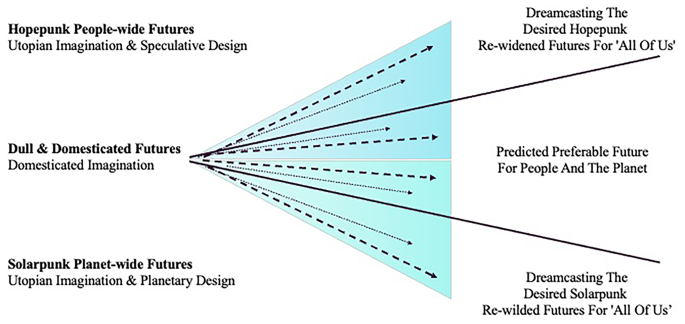
The domain of preferable/desired hopepunk and solarpunk futures that we might imagine within higher education. The pathways close to the middle of the cone are forecasted futures based on domesticated utopian imagination. In contrast, the pathways unfolding at the top are fuelled by utopian imagination with speculative design and lead us into hopepunk people-wide re-widened futures. The pathways unfolding in the bottom are fuelled by utopian imagination with planetary/pluriversal design and lead us into solarpunk planet-wide re-wilded futures
In general, there is a need to question current educational technology paradigms and approaches, listen and respond to planet-wide thinking, and include larger groups of people and species, past and future generations of all living beings – and even mountains and rivers (Friedman & Hendry, 2019 ; Hansen et al., 2022 ). Today, educational technology and design often happen within the hegemony of ego-centric Western and privileged positions, heavily affecting how we think about educational technology’s role in people’s lives, the planet, and the future(s). A change in thinking, doing, and being is needed to re-perceive, re-widen, and re-wild the what, how, and who of educational technology and its post-digital complexities with the world, resembling the entangled pedagogy proposed by Tim Fawns wherein elements co-constitute each other with agency configured and re-configured between all participants (Fawns, 2022 ).
Explicating how this might look, the article adopts and adapts similar work done within “More-than-Human Research Practices in HCI – A Scoping Review” (Eriksson et al., 2024 ). The review is based on 34 papers with more-than-human perspectives, taking different stances and approaches. Overall, the review shows that adopting more-than-human perspectives (including planetary design, solarpunk approaches, utopian imagination, and speculative design) to technology and design spans a wide spectrum. In the context of higher education and educational technology, this spectrum can be re-contextualised and framed into four different higher education orientations :
1) Higher education for the world through educational technology. 2) Higher Education in the world through educational technology. 3) Higher Education with the world through educational technology. 4) Higher Education by the world through educational technology.
Together, the four orientations denote a ‘normative shift’ in perspective from possible (that-which-could-be) to preferable (that-which-ought-to-be) planet-wide futures. This perspective confronts educational technology by asking it to imagine, explore, integrate, and enact opportunities for hopepunk and solarpunk interactions that extend and re-orient current thinking and practice within educational technology and higher education (Spors et al., 2023 ). According to Eriksson et al. ( 2024 ), the combined field of solarpunk, planetary design, and more-than-human futures is a new field within Human-Computer-Interaction (first paper from 2017) - and undoubtedly even more so when it comes to educational technology and higher education. As a case in point, none of the included publications in the scoping review on more-than-human Human-Computer Interaction addressed the domain of more-than-human education (Eriksson et al., 2024 ). The below sections will, therefore, in a beginning way, explore the four orientations constituting a preliminary design agenda for re-widening and re-wilding higher education with utopian imagination through solarpunk attitudes, more-than-human thinking and planetary design.
Higher education for the world through educational technology: an ecological university encompassing all of us
Within this orientation, educational technologies for the world exemplify our capacity to enact relations of care that extend beyond the ego-centric and encompass the broader world. It underscores the critical role that educational technology plays in redefining our collective ecological engagement through education for the world. Here, educational technology can engage the design agenda by integrating and promoting ecological teaching and learning toward more sustainable worlds and just futures. This perspective represents a vision of accessible, inclusive, and world-caring higher education locally and globally. Leveraging educational technology can help higher education integrate and enact education for the world as well as address the educational needs of a diverse and interconnected global society. However, pressing concerns signal immediate steps needed toward planet-wide educational institutions.
If we view for-profit educational technologies as the tamed realm of education and technology, these ‘for the world’ actions move us further from that domestication. They mitigate extreme overconsumption and strive for planetary sustainability. While some institutions have adopted these practices, they have yet to venture into the truly innovative and untamed territory advocated for in this article. Rewilding higher education through educational technology is about caring for the world through regeneration, renewal, and reshaping relations, which involves reflecting on how we might educate future generations in ways that are ‘for all of us as well as for the whole world.’ Here, educational technology should be used in ways that bring about the potential for a planet-wide university and higher education for the world. Macgilchrist ( 2021 ) argued that educational technology practices might involve co-creating speculative designs inspired by wild perspectives and exploring alternative technologies in education spaces. She further discussed that working towards radical approaches to educational technology is connected to critical utopias that avoid naïve optimism. They are developed with an awareness of historical and geopolitical injustices to counteract political pessimism by embodying collective hope. Here, rewilding educational technology points towards processes of deceleration, degrowth, restoration, and desires of regeneration (Wahl, 2006 ) that should be visible in both how we approach and practice educational technology.
Higher education in the world through educational technology: an engaged university sinking roots and evolving a crown in the world
Sometimes higher education is not ‘just’ for the world, but also in the world. From this orientation, educational technology is used to bring higher education into the world and enable teaching and learning to be practiced in the world. With a growing awareness of the climate crisis and the environmental impact of technology, the focus is on identifying and incorporating technological solutions and systems that can make education matter in the world as it unfolds. Ofer and Alistar ( 2023 ) emphasise the potential of this perspective in enabling us to take action in the world – in ways that are for the world – through technology as a tangible and sensory experience, creating life as shared experiences in the world within the realm of higher education.
Ofer and Alistar ( 2023 ) draw on, e.g., Wakkary ( 2021 ), who encourages a design approach that extends beyond human-centered design, emphasising a collaborative design perspective. He also suggests the development of repertoires, which are actions or tools that designers can employ to represent non-human elements better. This perspective thus resonates with the challenge of shifting the focus away from ego-centric design practices and utilising educational technology to enact higher education that is practiced for the world while being in the world.
Another perspective to approach in rewilding higher education and educational technology is the exploration of ecotones . Weller ( 2022 ) proposes a novel perspective on rewilding educational technology by considering the concept of ecotones, transition zones, and boundaries between distinct biological ecosystems, e.g., the marshland between dry and wet biomes. Typically, these areas exhibit a higher diversity of species, a phenomenon referred to as the edge effect , wherein richer and more diverse populations and communities can be observed. These can be related to the transitional phase of higher education striking root in the broader society/world. Rewilding could play a role in this context, making the technological ecosystem of higher education institutions more closely rooted in the great expanse of the World Wide Web, as mentioned by Weller ( 2022 ). Moreover, a more flexible and loosely structured educational technology system might not optimise students’ use of time, their performance towards desired grades, or the general robustness of the educational technology systems (Weller, 2022 , pp. 37–38).
In relation to Wellers’ application of ecotones, Ryberg et al. ( 2021 ) argue that post-digital thinking and theorising accentuate distinctions between digital and analog – or material and real. From a post-digital stance, such distancing is reductive and problematic. As such, they also discuss the concept of ecotones as a contribution to the field and how ecotone perspectives display relevant entanglements between education, technology, and the world, bearing fruit in the form of affective, conceptual, tensional, diverse, generative, and innovative properties (Ryberg et al., 2021 , pp. 421 − 420). The orientation leads us to embrace ecological agendas and planetary concerns while being in and of the world and committed to nurturing relationships and dependencies between different species, sites, realms, and futures in the world. The overarching goal is to prompt educational technology to awaken and sensitise higher education, extending its focus beyond human interests and needs to take root in the broader, untamed natural world. This approach represents a revitalisation and rewilding of higher education, characterised by hopepunk practices and utopian imagination, to forge paths and processes towards better alternative futures for all in the local and global contexts they think, act, and live in. Here, human well-being is intricately intertwined with the well-being of the entire world we inhabit.
Higher education with the world through educational technology: a worlding university of expanding planetary entanglements
This orientation seeks to nurture more symbiotic relationships between humans and the environment, reflecting eco-centric entanglement and pointing towards a significant contribution to the pluriversal design agenda proposed by Escobar ( 2017 ). This perspective delves into how educational technology can aid us in establishing solarpunk relationships with the more-than-human world and through technologies. It promotes connections and interactions within higher education built upon eco-centric entanglements through planetary design. Within this orientation, we can explore educational technologies that employ participatory approaches involving non-human stakeholders and leverage non-human storytelling to cultivate utopian imaginaries that transcend the human perspective. This holistic and reflexive approach is designed to enrich the landscape of higher education, as Nijs et al. ( 2020 ) highlighted.
In this context, integrating solarpunk practices with educational technologies catalyses the development of more desirable human relationships with the more-than-human world through educational technologies. This not only advances the evolution of educational technology but also reorients our own position from being in the world to being with the world. This is higher education as co-habitation with the world, emphasising the need for harmonious inter-species being and sustainable planetary co-existence. Haraway ( 2016 ) explores the idea of kinship - the integration of “diverse practices and ways of knowing for conjoined human and other-than-human becoming and exchange” (Haraway, 2016 , p. 153). The idea of kinship, fellowship, and the world as a planet-wide partner in higher education can help guide us towards more solarpunk approaches to educational technologies where we design, implement, and practice educational technology to promote being with the world. That is, it supports humans in living together with the world in respectful and appreciative ways where the planet is not positioned as something we can use as a resource or material for the future. Instead, the world is something we must ally to design new ways of life – also when it comes to how we think about and practice educational technology.
An example of this approach is Sheikh et al. ( 2021 ), which helps us consider how educational technologies can be employed to support higher education in the world by incorporating and visualising planetary and multi-species agencies and perspectives. The paper proposes a multi-species technological agency that supports designers and developers to move beyond egocentrism and ‘the human’ perspective towards multi-species assemblages wherein the planet is positioned as equal partners and participants.
To enable us to think and act with the world, Pollastri et al. ( 2021 ) put forward a five-point action plan that can be transformed into a solarpunk design agenda within the field of educational technology: (1) Shift the perspective from ego-centric to eco-centric that necessitate we design with the world; (2) Visualise planetary entanglements through educational technology and co-create higher education new solarpunk knowledges in higher education; (3) Position educational technology as a site for practicing higher education with the planet; (4) Re-imagine and re-configure higher education as a context for making preferable futures with a multi-species world; (5) Establish higher education as a transformational site for transitioning from ego-centric designing for to eco-centric designing with .
Higher education by the world through educational technology: a planetary university exceeding the human
The fourth and last orientation is probably also the most alien and esoteric of the orientations. And, by far, the most nascent. It asks of us the almost unimaginable. To imagine higher education as something not done by humans but created by the world. An illustrative case in point of higher education by the world through educational technology is the work of Livio and Devendorf ( 2022 ), who have introduced the concept of eco-technical interfaces . These interfaces open the possibility of envisioning non-human entities as the ‘creators’ of higher education by leveraging educational technology. This mind-bending approach has the potential to enable us to imagine planetary forces and entities as the post-human creators and architects of our world, including higher education; To see the world and our learning as something done to us by the world and not something we are the architects of.
Methods like Anna Tsing’s art of noticing ( 2015 ) can help us to shift away from our human orientation towards multi-sited, multi-species, and multi-sensory exploration of design and technology as something emanating from the world. One way forward would be to explore more symbiotic relationships between the world and us through educational technologies. Not as us entering a symbiotic relationship with the world, but as the world worlding us, making us – and higher education – part of its worldliness. In this framework, the natural world takes the lead, ‘speaks first’, initiates the discourse, and leads us toward novel, eco-centric, beyond-human outlooks regarding educational technology and higher education.
Through the notion of hopepunk and solarpunk, we have advocated for a shift in the domains of higher education and educational technology towards wider and wilder futures, focusing on utopian imagination, speculative design, and planetary thinking. This requires a shift in our perspectives and relationships with the world around us and a re-orientation of higher education as well as educational design and technology. The climate crisis and looming spectre of a planetary catastrophe has led to the emergence of various educational approaches, such as eco-pedagogies , post-digital and post-human thinking, and a planetary turn in design.
The design agenda drafted here can be seen as a response and potential strategy to address this (see Fig. 4 below). It is thus the article’s scholarly contribution to extend, reconfigure, and propose new ways of thinking about the interplay between higher education, educational technology, and utopian futures that deeply emphasises a planetary design perspective permeated by hopeful, just, and relational thinking. While there is a consensus among higher education scholars regarding the necessity for change, the scope and vision of this change are still emerging. We propose that higher education thinkers and technologists ‘dare to dream’ with hopepunk and solarpunk attitudes through a de-domestication of the utopian imagination. Wide and wide utopian imagination encourages a rebellious perspective where higher education is rewidened and rewilded by speculative and planetary design. By adopting a more holistic and optimistic approach, higher education institutions can better prepare for future challenges and create more preferable and desirable futures for both people and the planet.
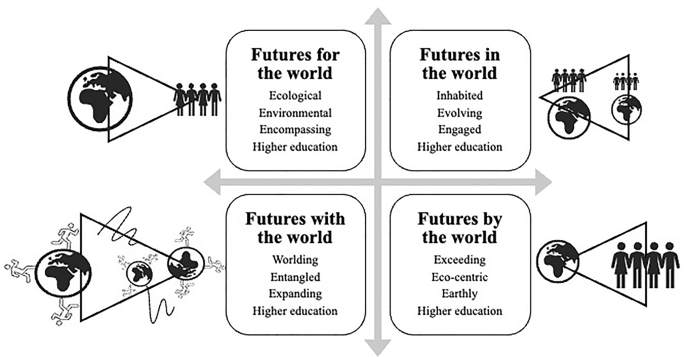
The four-grid model for solarpunk utopian educational technology for, in, with and by the world
Data availability
Not applicable.
Abegglen, S., Burns, T., Heller, R., & Sinfield, S. (2023). Designing Educational futures: Imagine a collaborative Bloom. Postdigit Sci Educ , 5 , 527–534. https://doi.org/10.1007/s42438-023-00393-w .
Article Google Scholar
Abensour, M. (1999). William Morris: The politics of Romance. In M. Blechman (Ed.), Revolutionary romanticism (pp. 125–161). City Lights.
Akama, Y., Light, A., & Kamihira, T. (2020). Expanding Participation to Design with More-Than-Human Concerns. In Proceedings of the 16th Participatory Design Conference 2020 - Participation(s) Otherwise - Volume 1 (PDC ‘20) . Association for Computing Machinery, New York, NY, USA, 1–11. https://doi.org/10.1145/3385010.3385016 .
Albrecht, G. (2019). After the Anthropocene . Retrieved October 3, 2023, from https://theecologist.org/2019/feb/27/after-anthropocene#:~:text=The%20Anthropocene%20is%20generating%20despair,The%20Symbiocene%20represents%20its%20opposite .
Alexander, B. (2023). Solarpunk as a way of redesigning higher education for the climate crisis . Retrieved October 3, 2023, from https://bryanalexander.org/future-trends-forum/solarpunk-as-a-way-of-redesigning-higher-education-for-the-climate-crisis/ .
Amsler, S., & Facer, K. (2017). Contesting anticipatory regimes in education: Exploring alternative educational orientations to the future. Futures , 94 , 6–14.
Ball, S. (2003). The teacher’s soul and the terrors of performativity. The Journal of Education Policy , 18 (2), 215–228. https://doi.org/10.1080/0268093022000043065 .
Banerji, D., & Paranjape, M. R. (Eds.). (2016). Critical posthumanism and planetary futures . Springer.
Barnett, R., et al. (2022). Culture and the university: Education, ecology, design . Bloomsbury Publishing.
Bayne, S. (2023). Digital education utopia. Learning Media and Technology , p. 1–16.
Bleecker, J., Foster, N., Girardin, F., & Nova, N. (2022). The Manual of Design Fiction . Near Future Laboratory.
Bodén, L., Ceder, S., & Sauzet, S. (2021). Editorial: Posthuman conceptions of change in empirical Educational Research. Reconceptualizing Educational Research Methodology , 12 (1). https://doi.org/10.7577/rerm.4215 .
Braidotti, R. (2013). The Posthuman . Polity.
Bridle, J. (2022). Ways of Being: Animals, Plants, Machines: the Search for a Planetary Intelligence . Penguin UK.
Dunne, A., & Raby, F. (2013). Speculative everything: Design, fiction, and social dreaming . The MIT.
Eriksson, E., Nilsson, E. M., Bekker, T., & Yoo, D. (2024). More-than-human practices in Human-Computer Interaction Research – A Scoping Review . Manuscript submitted for review.
Escobar, A. (2017). Designs for the Pluriverse: Radical interdependence, autonomy, and the making of worlds . Duke University Press. http://www.jstor.org/stable/j.ctv11smgs6 .
Fawns, T. (2022). An entangled pedagogy: Looking beyond the Pedagogy—Technology Dichotomy. Postdigit Sci Educ , 4 , 711–728. https://doi.org/10.1007/s42438-022-00302-7 .
Fitting, P. (2009). A short history of Utopian studies. Science Fiction Studies , 36 (1), 121–131. http://www.jstor.org/stable/25475211 .
Google Scholar
Flynn, A. (2014). Solarpunk: Notes toward a manifesto Retrieved October 3, 2023, from https://hieroglyph.asu.edu/2014/09/solarpunk-notes-toward-a-manifesto/ .
Friedman, B., & Hendry, D. G. (2019). Value Sensitive Design: Shaping Technology with Moral Imagination . MIT Press.
Gillam, W. J. (2023). A Solarpunk Manifesto: Turning Imaginary into Reality. Philosophies , 8(4), 73. MDPI AG. Retrieved from https://doi.org/10.3390/philosophies8040073 .
Gravett, K. (2023). Relational pedagogies: Connections and mattering in higher education (1. ed.). Bloomsbury Academic.
Grzyb, L. (2017). In L. Grzyb, & C. Sparks (Eds.), Ecopunk! Speculative tales of radical futures (pp. 15–16). Ticonderoga.
Hall, T., Wegerif, R., Loper, S., Chróinín, D. N., & O’Brien, E. (2022). Digital education futures: Design for doing education differently. Irish Educational Studies , 41 (1). https://doi.org/10.1080/03323315.2021.2022072 .
Hansen (2022). Teaching for more-than-human perspectives in technology design–towards a pedagogical framework. In Cumulus Conference Design for Adaptation hosted by College for Creative Studies , Detroit, Michigan, USA on November 2–4, 2022.
Haraway, D. J. (2016). Staying with the trouble: Making Kin in the Chthulucene . Duke University Press. https://doi.org/10.2307/j.ctv11cw25q .
Holflod, K. (2023a). Playful Higher Education Futures: Hopeful and Utopian Thinking in Pedagogy, in Abegglen, S., Burns, T., Heller, R., Madhok, R., Sandars, J., Sinfield, S., & Singh, U.G. (Eds.) Stories of Hope - Reimagining Education . [In Press].
Holflod, K. (2023b). Playful collaboration in Higher Education – Imagining a Relational Pedagogy of Care, Interdependence and Soulfulness. In R. T. Nørgård, & N. Whitton (Eds.), The Playful University . Routledge. [In Press].
Holflod, K., Bayne, S., & Nørgård, R. T. (2023). Playing with Futures and Utopia: Speculating Other Worlds in Higher Education for the More-Than-Human . Paper presented at the GRASP Festival 2023.
Johnson, I. (2010). Solarpunk & the pedagogical value of utopia . Education, 2010.
Kahn, R. V. (2010). Critical pedagogy, ecoliteracy, & planetary crisis: The ecopedagogy movement (Vol. 359). Peter Lang.
Levitas, R. (1990). Educated Hope: Ernst Bloch on Abstract and Concrete Utopia. Utopian Studies , 1 (2), 13–26.
Levitas, R. (2004). Hope and Education, Journal of Philosophy of Education , Volume 38, Issue 2, May 2004, Pages 269–273, https://doi.org/10.1111/j.0309-8249.2004.00381.x .
Levitas, R. (2013). Utopia as method . Palgrave Macmillan.
Levitas, R. (2017). Where there is no vision, the people perish: A utopian ethic for a transformed future. CUSP essay series on the Ethics of Sustainable Prosperity, 5 . http://www.cusp.ac.uk/wp-content/uploads/05-Ruth-Levitas-Essay-online.pdf .
Livio, M., & Devendorf, L. (2022). The Eco-Technical Interface: Attuning to the Instrumental. In CHI Conference on Human Factors in Computing Systems (CHI ‘22) , April 29-May 05, 2022, New Orleans, LA, USA. ACM, New York, NY, USA, 17 Pages. https://doi.org/10.1145/3491102.3501851 .
Macgilchrist, F. (2021). Rewilding technology. On Education. Journal for Research and Debate , 4 (12). https://doi.org/10.17899/on_ed.2021.12.2 .
Mancuso, C. (2021). The Two Speculations: The Poetics of Contemporary Speculative Fiction . Doctoral dissertation, Harvard University Graduate School of Arts and Sciences.
Misiaszek, G. W. (2020). Ecopedagogy: Teaching critical literacies of ‘development’, ‘sustainability’, and ‘sustainable development’. Teaching in Higher Education , 25 (5), 615–632. https://doi.org/10.1080/13562517.2019.1586668 .
Molina-Motos, D. (2019). Ecophilosophical principles for an ecocentric environmental education. Education Sciences , 9 (1), 37.
Monteiro, M. (2019). Ruined by design: How designers destroyed the World, and what we can do to fix it . Mule Books.
Nelson, H. G., & Stolterman, E. (2014). The design way: Intentional change in an unpredictable world . MIT Press.
Nijs, G., Laki, G., Houlstan, R., Slizewicz, G., & Laureyssens, T. (2020). Fostering More-than-Human Imaginaries: Introducing DIY Speculative Fabulation in Civic HCI. In Proceedings of the 11th Nordic Conference on Human-Computer Interaction: Shaping Experiences, Shaping Society (NordiCHI ‘20) . Association for Computing Machinery, New York, NY, USA, Article 36, 1–12. https://doi.org/10.1145/3419249.3420147 .
Nørgård, R. T. (2022). What comes after the ruin? Designing for the arrival of preferable futures for the university. Transformation of the University (pp. 156–174). Routledge.
Ofer, N., & Alistar, M. (2023). Felt Experiences with Kombucha Scoby: Exploring First-person Perspectives with Living Matter. In Proceedings of the 2023 CHI Conference on Human Factors in Computing Systems (CHI ‘23) , April 23–28, 2023, Hamburg, Germany. ACM, New York, NY, USA 18 Pages. https://doi.org/10.1145/3544548.3581276 .
Pollastri, P., Griffiths, R., Dunn, N., Cureton, P., Boyko, C., Blaney, A., & De Bezenac, E. (2021). More-Than-Human Future Cities: From the design of nature to designing for and through nature. In Media Architecture Biennale 20 (MAB20) Association for Computing Machinery, New York, NY, USA, pp. 23–30. https://doi.org/10.1145/3469410.3469413 .
Project Hieroglyph (2014, September 4). Solarpunk: Notes toward a manifesto . Retrieved the 28th of October, 2023, from: https://hieroglyph.asu.edu/2014/09/solarpunk-notes-toward-a-manifesto/ .
Reina-Rozo, J. D. (2021). Art, Energy and Technology: The Solarpunk Movement. International Journal of Engineering Social Justice and Peace , 8 (1), 47–60. https://doi.org/10.24908/ijesjp.v8i1.14292 .
Romano, A. (2018). Hopepunk, the latest storytelling trend, is all about weaponized optimism. Vox . Retrieved from https://www.vox.com/2018/12/27/18137571/what-is-hopepunk-noblebright-grimdark .
Ross, J. (2022). Digital Futures for Learning: Speculative Methods and Pedagogies (1st ed.). Routledge. https://doi.org/10.4324/9781003202134 .
Ryberg, T., Davidsen, J., Bernhard, J., et al. (2021). Ecotones: A conceptual contribution to Postdigital thinking. Postdigit Sci Educ , 3 , 407–424. https://doi.org/10.1007/s42438-020-00213-5 .
Samson, K., & Haldrup, M. (2023). A planetary turn for design? Speculations on withdrawal and cohabitation, in Holmlid, S., Rodrigues, V., Westin, C., Krogh, P. G., Mäkelä, M., Svanaes, D., Wikberg-Nilsson, Å (Eds.), Nordes 2023: This Space Intentionally Left Blank , 12–14 June, Linköping University, Norrköping, Sweden. https://doi.org/10.21606/nordes.2023.81 .
Sheikh, H., Gonsalves, K., & Foth, M. (2021). Plant(e)tecture: Towards a Multispecies Media Architecture Framework for Amplifying Plant Agencies. In Media Architecture Biennale 20 (MAB20) Association for Computing Machinery, New York, NY, USA, pp. 87–99. https://doi.org/10.1145/3469410.3469419 .
Snaza, N., Appelbaum, P., Bayne, S., Carlson, D., Morris, M., Rotas, N., Sandlin, J., Wallin, J., & Weaver, J. A. (2014). Toward a Posthuman Education. Journal of Curriculum Theorizing , 30 (2): 39–55: PKP Publishing Services Network. https://digitalcommons.georgiasouthern.edu/curriculum-facpubs/47 .
Spors, V., Laato, S., Buruk, O., & Hamari, J. (2023). Longing to be the Mountain: A Scoping Review about Nature-Centric, Health-Minded Technologies. In Proceedings of the 2023 CHI Conference on Human Factors in Computing Systems (CHI ‘23). Association for Computing Machinery, New York, NY, USA, Article 523, 1–16. https://doi.org/10.1145/3544548.3581479 .
Sylva, R. (2015). Solarpunk: We are golden, and our future is bright . Retrieved October 3, 2023, from www.scifiideas.com/writing-2/solarpunk-we-are-golden-and-our-future-is-bright/ .
Tsing, A. L. (2015). The mushroom at the end of the World: On the possibility of life in Capitalist ruins . Economics Books, Princeton University Press.
Ulibarri, S. (2018). Preface. In G. Lodi-Ribeiro (Ed.), Solar punk: Ecological and fantastical stories in a sustainable world (pp. 1–3). (F. Fernandes, Trans.). Albuquerque, NM: World Weaver Press.
Voros, J. (2001). A primer on futures studies, foresight and the use of scenarios. Prospect: The Foresight Bulletin , 6 (1), 1–8.
Voros, J. (2017, February 24). The Futures Cone, use and history . The Voroscope. https://thevoroscope.com/2017/02/24/the-futures-cone-use-and-history/ .
Wahl, D. (2006). Design for human and planetary health. Unpublished doctoral thesis, Dundee University .
Wahl, D. C. (2016). Designing regenerative cultures . Triarchy.
Wakkary, R. (2021). Things we could Design: For more Than Human-centered worlds . MIT Press.
Webb, D. (2016). Educational studies and the domestication of Utopia. British Journal of Educational Studies , 64 (4), 431–448. https://doi.org/10.1080/00071005.2016.1143085 .
Wegerif, R. (2022). 9. Beyond Democracy: Education as Design for Dialogue. In Liberal Democratic Education: A Paradigm in Crisis. Leiden, The Netherlands: Brill | mentis. https://doi.org/10.30965/9783969752548_010 .
Weller, M. (2022). Metaphors of Ed Tech . Athabasca University. https://read.aupress.ca/projects/metaphors-of-ed-tech .
Download references
The authors declare that there are no funding.
Author information
Authors and affiliations.
Danish School of Education, Aarhus University, Campus Aarhus Nobelparken, bygning 1483 Jens Chr. Skous Vej 4, Aarhus C, 8000, Denmark
Rikke Toft Nørgård & Kim Holflod
You can also search for this author in PubMed Google Scholar
Contributions
The authors declare that they have co-written the article and share authorship between them.
Corresponding author
Correspondence to Rikke Toft Nørgård .
Ethics declarations
Competing interests.
The authors declare that there are no competing interests.
Additional information
Publisher’s note.
Springer Nature remains neutral with regard to jurisdictional claims in published maps and institutional affiliations.
Rights and permissions
Open Access This article is licensed under a Creative Commons Attribution 4.0 International License, which permits use, sharing, adaptation, distribution and reproduction in any medium or format, as long as you give appropriate credit to the original author(s) and the source, provide a link to the Creative Commons licence, and indicate if changes were made. The images or other third party material in this article are included in the article’s Creative Commons licence, unless indicated otherwise in a credit line to the material. If material is not included in the article’s Creative Commons licence and your intended use is not permitted by statutory regulation or exceeds the permitted use, you will need to obtain permission directly from the copyright holder. To view a copy of this licence, visit http://creativecommons.org/licenses/by/4.0/ .
Reprints and permissions
About this article
Cite this article.
Nørgård, R.T., Holflod, K. (No) Hope for the future? A design agenda for rewidening and rewilding higher education with utopian imagination. Int J Educ Technol High Educ 21 , 30 (2024). https://doi.org/10.1186/s41239-024-00456-3
Download citation
Received : 06 November 2023
Accepted : 18 March 2024
Published : 26 April 2024
DOI : https://doi.org/10.1186/s41239-024-00456-3
Share this article
Anyone you share the following link with will be able to read this content:
Sorry, a shareable link is not currently available for this article.
Provided by the Springer Nature SharedIt content-sharing initiative
- Utopian imagination
- Higher education
- Educational technology
- Speculative design
- Planetary design
- Futures thinking
- Utopian higher education.
New Marlborough boarding school stressing innovation has 15 in first graduating class

MARLBOROUGH — In the fall of 2021, 15 students began taking a chance on a very different approach to high school. Now they're on the cusp of graduating from an innovative program that aims to change the model of contemporary education .
"At NEIA, you can either do nothing, or you can do all of the things you ever wanted," said Hans-Peter Hansen, a senior from Chatham.
"NEIA" stands for the New England Innovation Academy , an independent private school founded in 2021 at a former Verizon call center on Locke Drive. The school launched with 75 students, the oldest of whom were 10th graders and who would go on to become its first graduating class. The school since has expanded its footprint, now enrolling 150 students across middle and high school.
'Not ivory tower conceptual topics': New college preparatory boarding school opens in Marlborough
NEIA doesn't provide traditional grading or curriculum, nor does it offer AP courses. Instead, students focus on innovation, project management and collaboration, using technology and other tools to focus on what administrators consider to be an evolving form of education.
It isn't cheap. NEIA’s published tuition rates for 2023-24 for day students are $44,150 for grades 7-8 and $48,730 for grades 9-12, according to the school website; rates for residential students are $67,050 for grades 7-8 and $71,630 for grades 9-12.
"Too many schools look backward at the traditions and cultures of what was, at what is often called the factory model of education, where rote learning in rows, obedience and compliance seems to be the order of the day," said Tom Woelper, NEIA's Head of School . "This is a school where our founders really believe that school is more about preparing students accurately for this changing world. A vision that is not stuck in the cultural inertia that a lot of schools are."
NEIA puts focus on applying skills, creative and entrepreneurial thinking
One example of such applied learning occurred when students worked on real designs for a roller-skating company, including engaging in a real pitch meeting with company executives. NEIA's campus includes a room specifically designed for student entrepreneurship, where students draw up contracts and work collaboratively on real-world business models.
"Too much education is focused on content mastery and regurgitation," Woelper said. "I think there's a certain reality where content is always going to be important, but there needs to be a certain focus toward skills, application mindsets and dispositions."
Students who are set to graduate this spring pointed out that NEIA differs from other schools in that its discovery-based learning model allows them to integrate their own interests into their education.
"When I was first introduced to NEIA, I saw that it was such a unique learning style," said senior Catherine Martz, a Michigan resident and one 45 students who board at the school. "It was very interesting to see how you could follow your passion through school, which was something that I wasn't able to do at any of my other schools. I was able to try new things — I got a chance to create a vegetarian cookbook as part of a project last year, and it was really cool to be able to make food that I'm passionate about, and have that be for a class."
'A world that looks different': New college prep boarding school planned for Marlborough
When the Class of 2024 started at NEIA — which opened right after the peak of the pandemic — the school still had more growing to do. It lacked robust athletic fields, a lecture hall and various extracurricular activities. Slowly, those programs have been added, often at the request of students who took initiative themselves.
"There were a couple of juniors that started at NEIA this year, and they had come from another school that had a varsity robotics team," said Darshan Balaji, a senior from Burlington. "They had a huge passion for it and they wanted to start a team , so they did and last week the team qualified for the world championship event in Houston."
NEIA official says school requires students to advocate for themselves
Assistant Head of School Ben Farrell said NEIA requires students to advocate for themselves more than in other educational programs, which helps them learn important life skills.
"I think to be a really good student at NEIA, you have to be able to advocate for yourself, and that seems like a very basic thing, but at every school I've worked at, everyone talks about how to find ways to teach kids to empower students," he said. "But here, these students, they have a real voice and we listen to them. If a student comes to me and says they have a thought about something, I'm going to listen and we're going to try and work on something like that. The idea of being innovative, and having that innovative spirit, runs throughout all of us."
Senior year would prove to be a major test for not only the Class of 2024, but NEIA in general, as students began to apply for college. Given the school's nontraditional model, it remained to be seen how interested colleges would be in NEIA's students.
'A proven strategy': FSU, MassBay join alliance to increase students in early college programs
"The college process can often be very difficult at a lot of schools, the class can be cagey and competitive," Farrell said. "At this school, they all had each other's back and were very supportive, because they knew they were going through something that was unique together — they knew the only other people in the world that knew what they were going through was that class of 15."
The results would suggest that NEIA achieved a major success, with all members of the graduating class getting accepted into such colleges as New York University , the University of Michigan and the Savannah College of Art and Design .
'We really talk about passion and purpose'
"One advantage we saw is that if you go to a school that has a real traditional curriculum, you will be compared to other schools that have a traditional curriculum," Woelper said. "Our kids don't look like those students. We really talk about passion and purpose, experience-based learning, and we talk about the ability to start your own company, or found your own robotics team that just qualified for the world championship.
"And colleges are responding."
Besides providing unique resumes for college, the education at NEIA provided useful feedback to allow students to decide what they're interested in pursuing.
Jack Antonangeli, a senior from Lancaster, said he came to NEIA after attending a Montessori school through eighth grade, then spending ninth grade learning online. He said his time at NEIA gave him valuable information on how he wants to pursue his education after graduating.
"One of the things I realized while attending NEIA was that I really don't want to be working a traditional 9-to-5 job," Antonangeli said. "So I'm going to take a gap year and try some different things. I'm going to start by working on a farm this summer. When I figure out what I want to pursue, I'm going to attend Hampshire College."

IMAGES
VIDEO
COMMENTS
Design Thinking in Education. Design Thinking is a mindset and approach to learning, collaboration, and problem solving. In practice, the design process is a structured framework for identifying challenges, gathering information, generating potential solutions, refining ideas, and testing solutions. Design Thinking can be flexibly implemented ...
The article discusses design thinking as a process and mindset for collaboratively finding solutions for wicked problems in a variety of educational settings. Through a systematic literature review the article organizes case studies, reports, theoretical reflections, and other scholarly work to enhance our understanding of the purposes, contexts, benefits, limitations, affordances, constraints ...
The fifteen chapters were developed by leaders in the field and represent the most updated and cutting edge methodology in the areas of instructional design and instructional technology. The broad concepts of design, design thinking, the design process, and the design studio, are identified and they form the framework of the book. This book ...
Education needs new ways to prepare individuals and societies for the multitude of changing challenges in the twenty-first century. In today's world—characterized by digitization, increasing speed, and complexity—design thinking has established itself as a powerful approach to human-centered innovation that can help address complicated problems and guide change in all areas of life.
Design thinking is both a method and a mindset. What makes design thinking unique in comparison to other frameworks such as project based learning, is that in addition to skills there is an emphasis on developing mindsets such as empathy, creative confidence, learning from failure and optimism. Seeing their students and themselves enhance and ...
How design and design thinking can and should be taught or used has been an issue of importance in different professional fields. Different models have been identified and developed for different purposes including education (e.g., Wright and Wrigley 2019; Wrigley and Straker 2015) and assessment (e.g., Kretzschmar 2003).For example, Wrigley and Straker proposed an educational design ladder ...
Design Thinking is versatile. Design Thinking remains equally impactful at the activity, project, course, or program scale. The design process can be employed in its entirety over several months or as a component of another methodology. Design Thinking can be explored directly as an approach or in pursuit of other academic or collaborative work.
thinking process and mindset as a learning goal in and. of itself; (5) design thinking in student support, i.e., mentoring, advising, c ounseling; (6) design thinking for. process improvement or ...
Regarding pedagogical approaches, design thinking is applied in K-12 education to promote collaborative and creative problem solving among learners across the curriculum (Carroll et al., 2010), with a strong presence in STEM (science, technology, engineering, and mathematics) subjects (a typical application of design thinking is within ...
Come explore these questions and more in Design Thinking for Leading and Learning. The course is organized into three sections that combine design thinking content with real-world education examples, as well as opportunities for learners to apply concepts in their own setting. Unit 1: Meet Design Thinking. An introduction to design thinking ...
Come explore these questions and more in Design Thinking for Leading and Learning. The course is organized into three sections that combine design thinking content with real-world education examples, as well as opportunities for learners to apply concepts in their own setting. This course is part of the [Open Learning Library] (https ...
the adoption of design thinking in education. For example, Goldman, Kabayadondo, Royalty, Carroll, and Roth (2014) stated that in in over 60 US universities and colleges, design thinking is taught through workshops, supplemental training, courses, or degree programs. Similarly, Callahan (2019) observed that design thinking
This book is the result of a research symposium sponsored by the Association for Educational Communications and Technology [AECT]. The fifteen chapters were developed by leaders in the field and represent the most updated and cutting edge methodology in the areas of instructional design and instructional technology.
Overview. Design thinking is a methodology for creative problem solving. You can use it to inform your own teaching practice, or you can teach it to your students as a framework for real-world projects. The set of resources on this page offer experiences and lessons you can run with your students. This gives educators interested in teaching ...
The educational landscape continues to become increasingly complex, which suggests a need for a teacher-driven creative approach to developing instructional lessons. This article introduces the Design Thinking and Instructional Lessons (DTAIL) model and describes its three-phase development. In Phase I, the Design Thinking literature and the first draft of the model are described. In Phase II ...
Design thinking has been successfully practiced as an educational framework for supporting innovation in educational and work contexts. However, research on design thinking education that facilitates the acquisition of knowledge related to design process and practices is extremely limited, particularly in educational contexts.
Design thinking has been successfully practiced as an educational framework for supporting innovation in educational and work contexts. However, research on design thinking education that facilitates the acquisition of knowledge related to design process and practices is extremely limited, particularly in educational contexts.
Through a systematic literature review the article organizes case studies, reports, theoretical reflections, and other scholarly work to enhance our understanding of the purposes, contexts, benefits, limitations, affordances, constraints, effects and outcomes of design thinking in education.
Design Thinking in Education: Empathy, Challenge, Discovery, and Sharing. As a model for reframing methods and outcomes, design thinking reconnects educators to their creativity and aspirations for helping students develop as deep thinkers and doers.
Design thinking is future oriented, concerned with "the conception and realization of new things," and at its core is focused on "planning, inventing, making, and doing" (Cross, 1997, p.1), all of which are of value to the field of educational technology.
A solutions-based approach to solving problems. An iterative, non-linear process. A way of thinking and working. Supported by a collection of strategies and methods. Design Thinking asks us to: Develop empathy and understand the needs of the people we are designing solutions for. Define problems and opportunities for designing solutions.
"The authors clearly define the aims of the text as being to further the debate amongst teachers, teacher educators and educational researchers on the theoretical development of design thinking within the context of educational settings. … a book that would hold appeal for all of those with an interest in design thinking in an educational context, irrespective of their position ...
Learn about design thinking, STEM education, and Education Technology. David Lee EdTech. top of page. HOME. ABOUT; PEDAGOGY. Design Thinking in Education; ... Consultant, Certified Wix Trainer, M.Ed. Educational Technology, Former STEM Coordinator, Design Specialist, and ICT Teacher. Official partner of DesignGoes2School
Application of design thinking in K-12 education domain. Stanford d.school, a pioneer in promoting DT, applied DT as a new learning model in K-12 education (Kwek, 2011). Since then, numerous initiatives have emerged to promote and explore DT as a learning paradigm in K-12 classrooms (Kwek, 2011; Noel & Liub, 2017; Norman, 2000). Two practical ...
In recent years, "Internet plus education" has gradually emerged and educational informatization has been developed rapidly. However, the discipline development of educational technology is becoming weak. How to change this phenomenon has become a major challenge in educational technology. The core of design thinking is problem solving. The design thinking can well cultivate students ...
Against the backdrop of a complex Higher Education (HE) landscape, particularly in a developing country context where the relevance of current HE structures is questioned through student protests, and decolonisation of education practices is called for, traditional thinking is losing ground. This study focuses on lecturers identified as eLearning champions, who display shared dispositions that ...
This article argues for exploring, connecting, and applying utopian imagination, speculative design, and planetary thinking as a way forward for higher education to reimagine and move towards more hopeful planetary futures. It examines hopepunk and solarpunk perspectives on possible futures to propose a design agenda for rewidening and rewilding higher education and educational technology with ...
The 4S Model, which combines design thinking and technology development approaches for adopting AI-based solutions, draws on the theoretical lens of microfoundations, defining (1) the process phases (storming, solving, scoping, scaling); (2) the individuals involved (designers, technology experts, users); and (3) the structure and tools ...
The purpose of this study is to evaluate how the ChopMelon Net online learning platform can contribute to the effectiveness of sustainable education by incorporating real social issues. The core innovation of ChopMelon Net is that it provides a learning environment that connects learners directly to real-world challenges and aims to enhance learners' understanding of sustainable development ...
It isn't cheap. NEIA's published tuition rates for 2023-24 for day students are $44,150 for grades 7-8 and $48,730 for grades 9-12, according to the school website; rates for residential ...